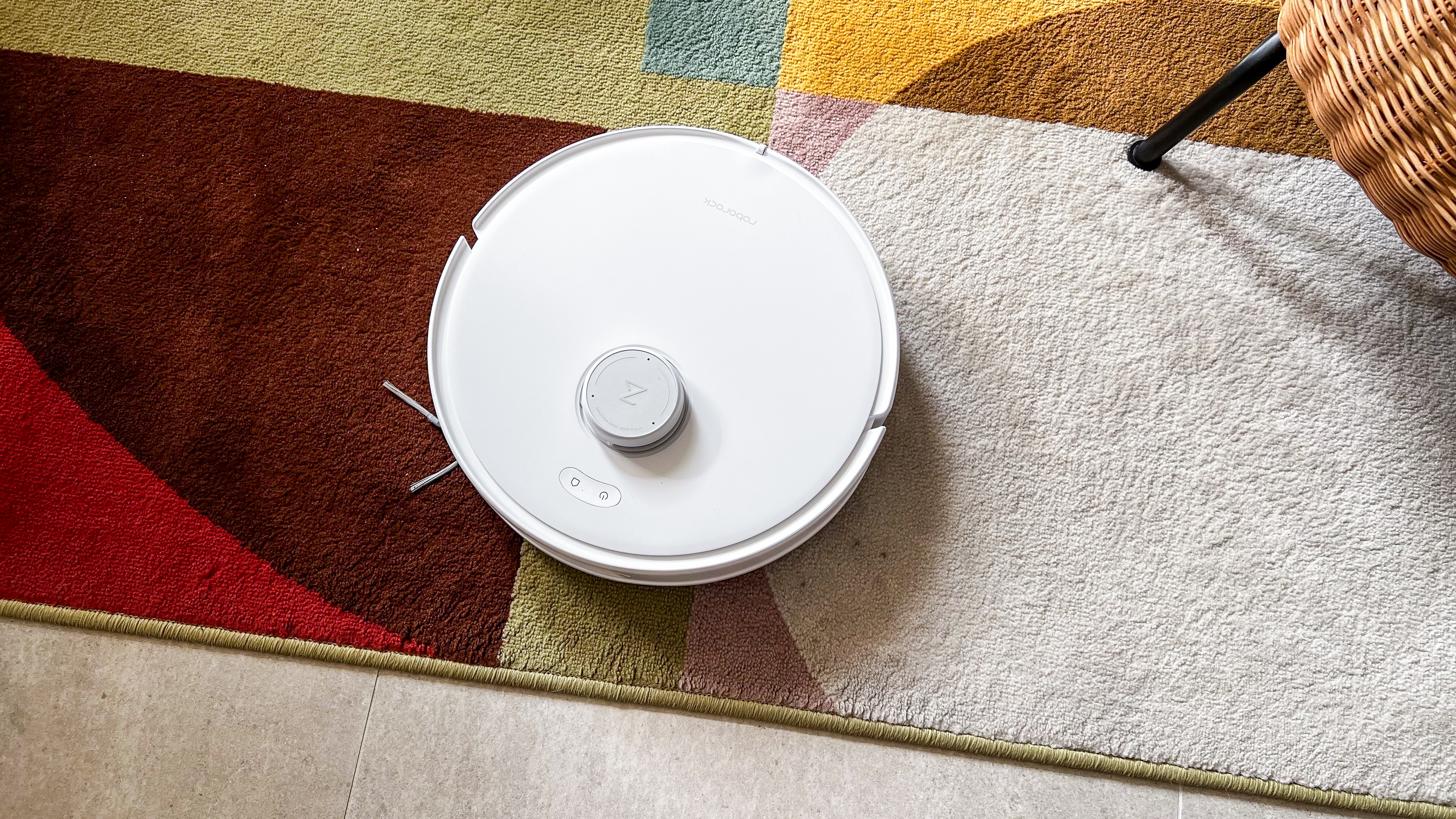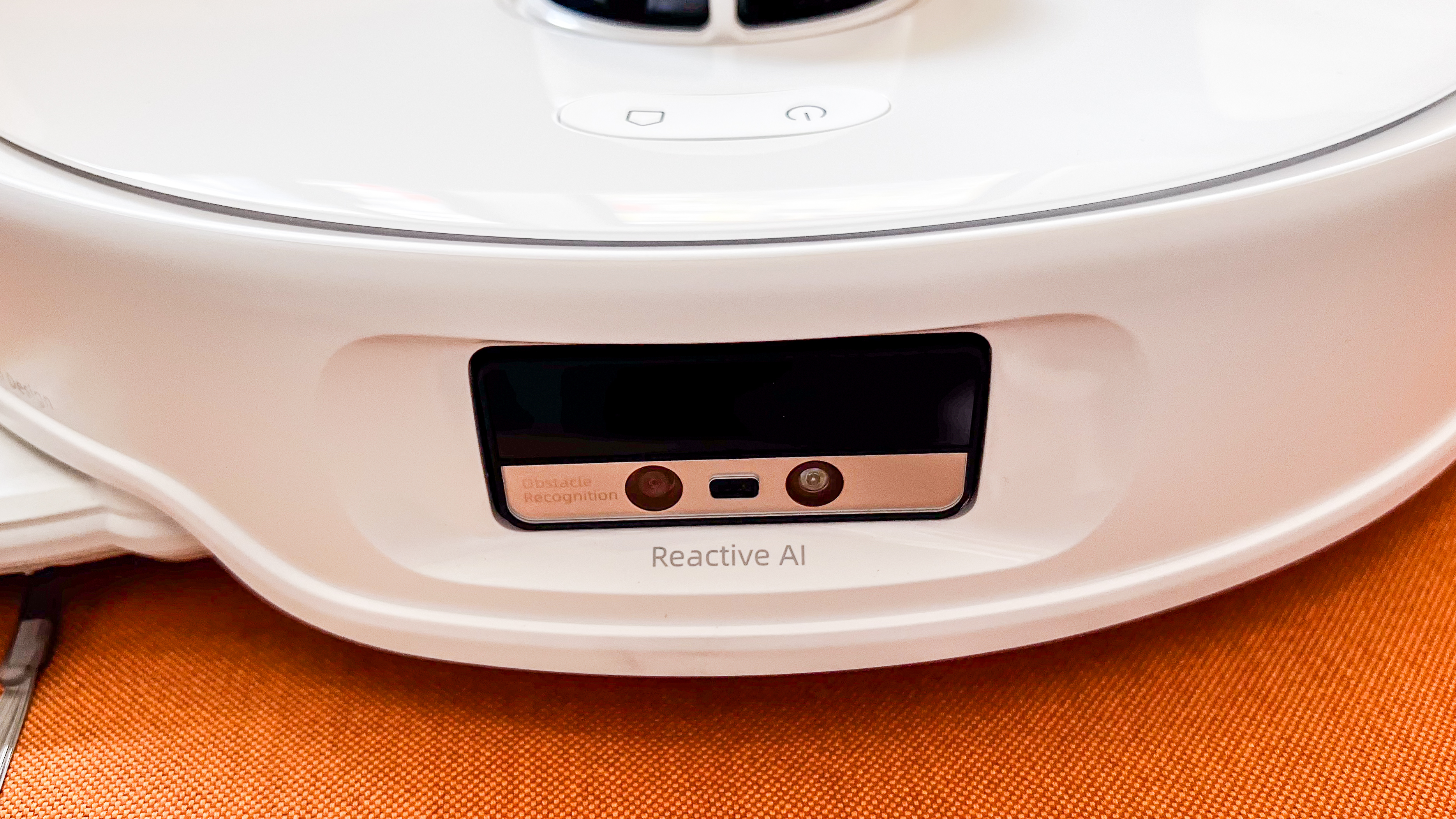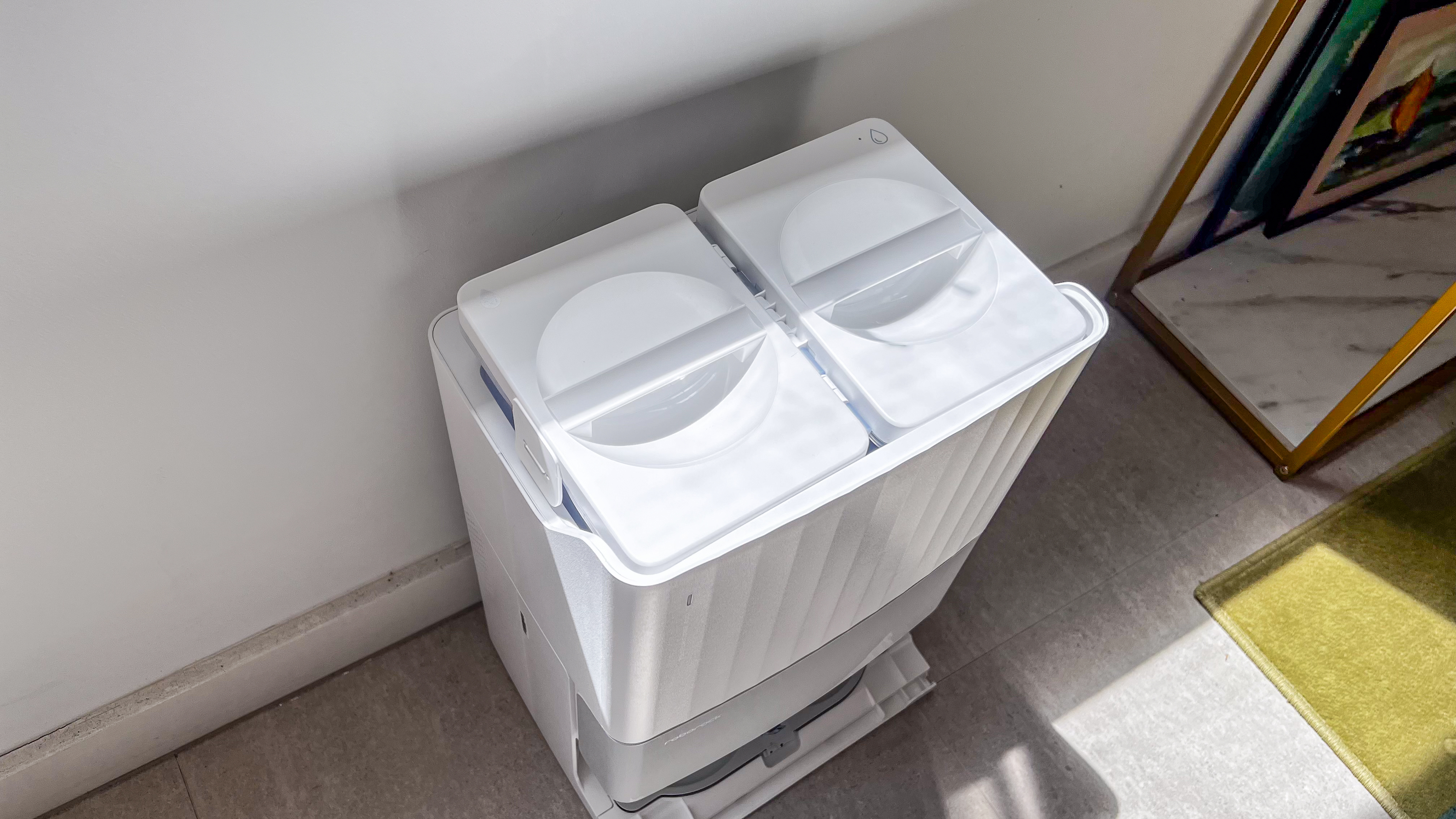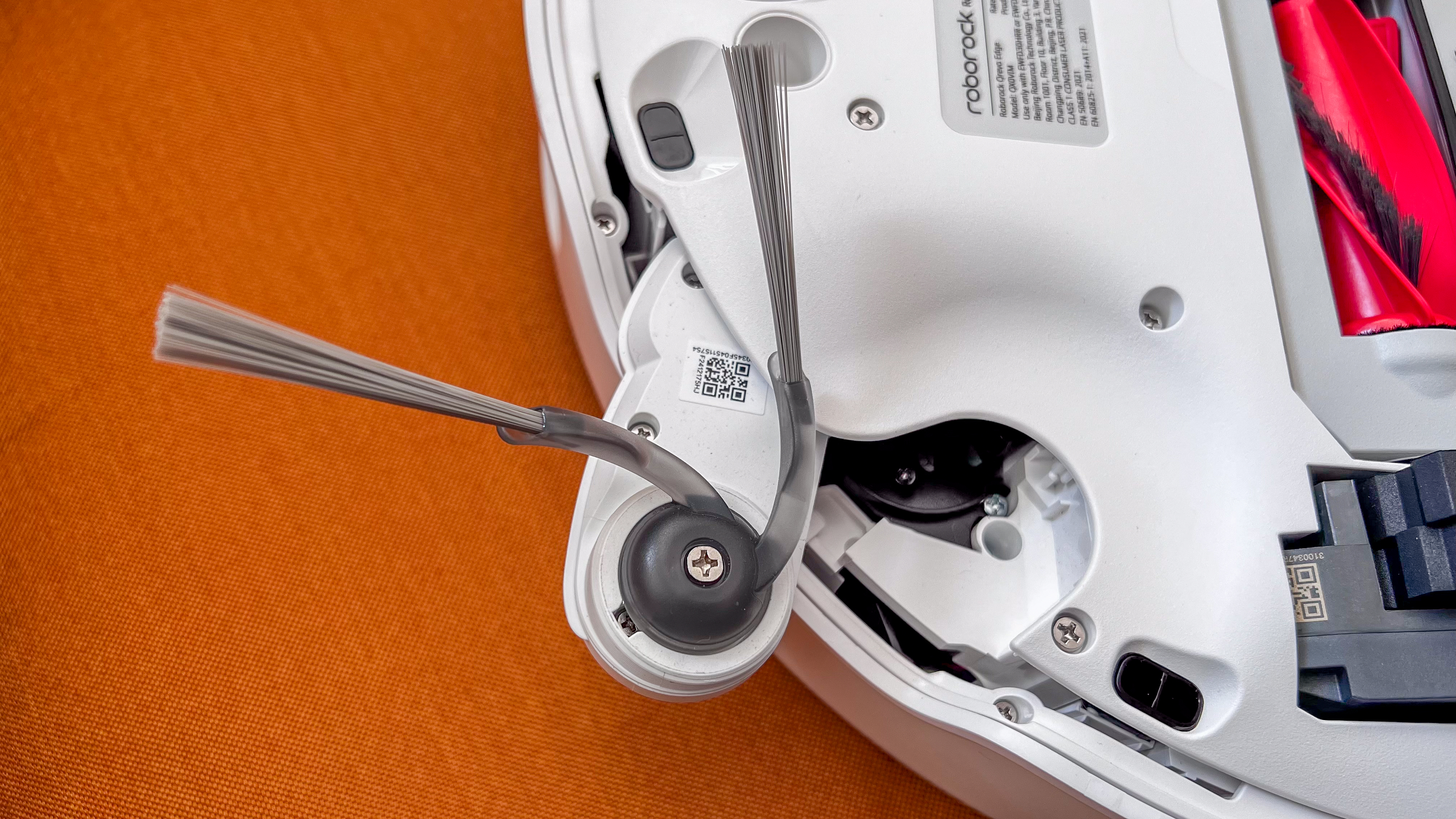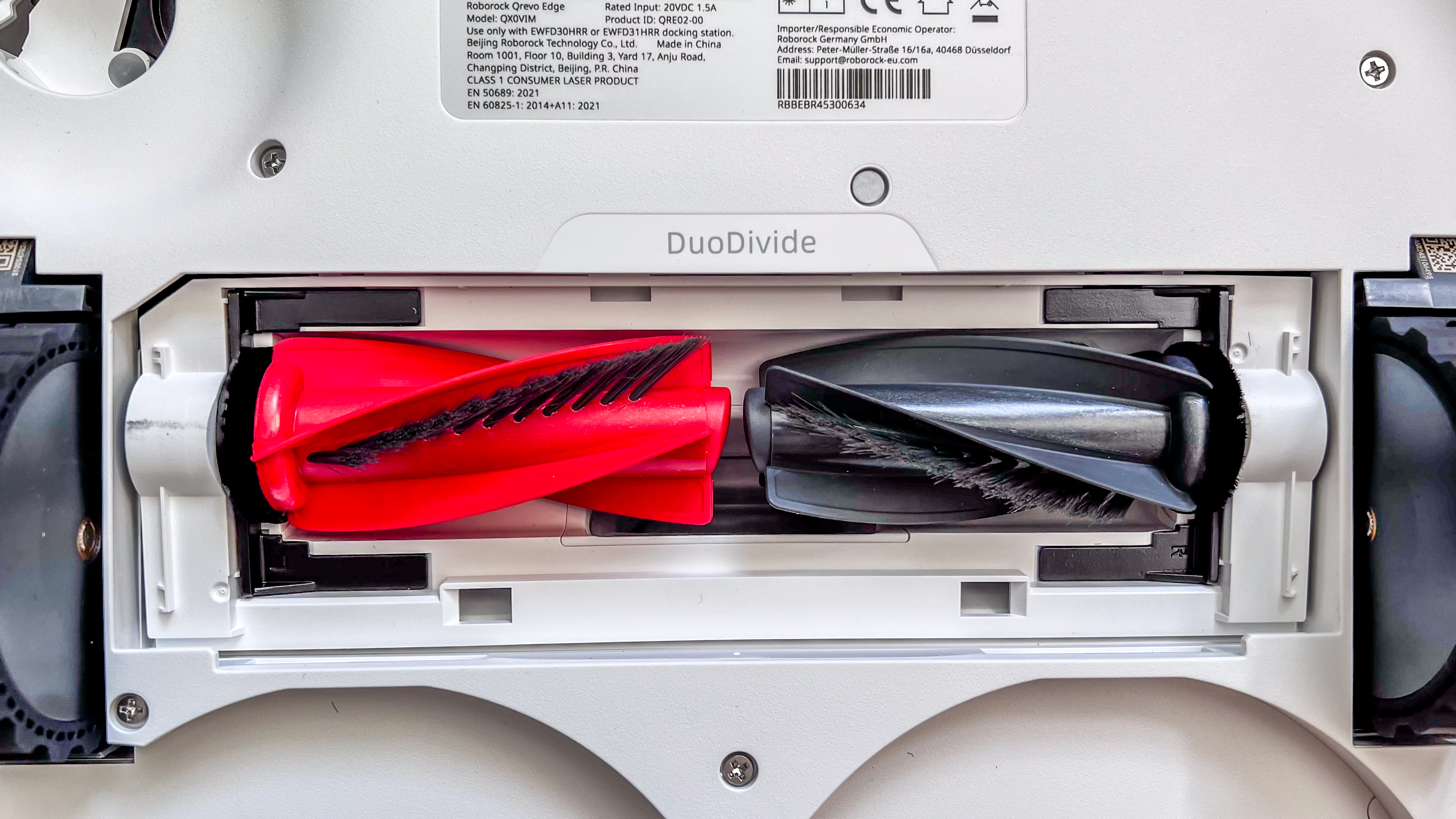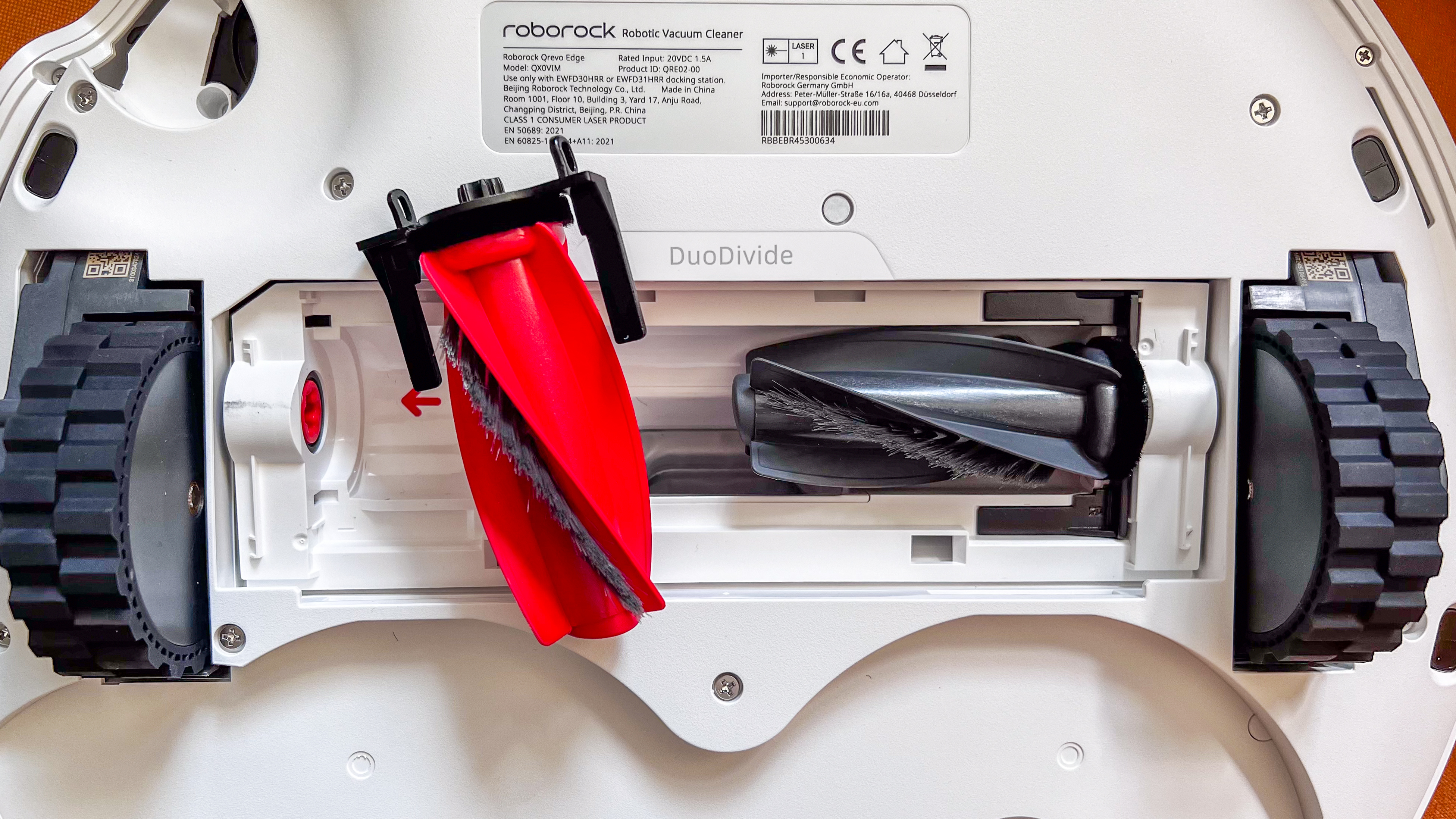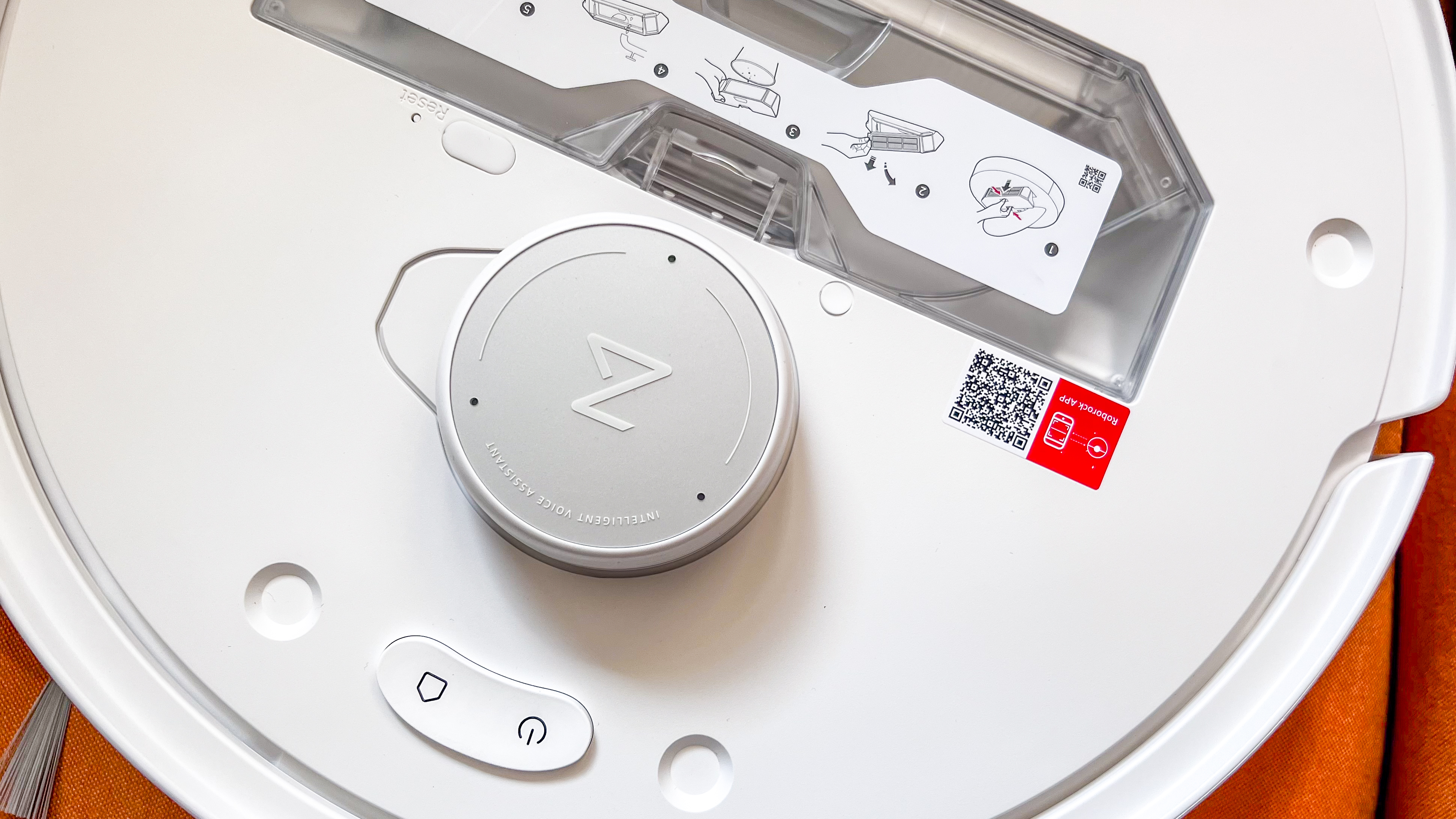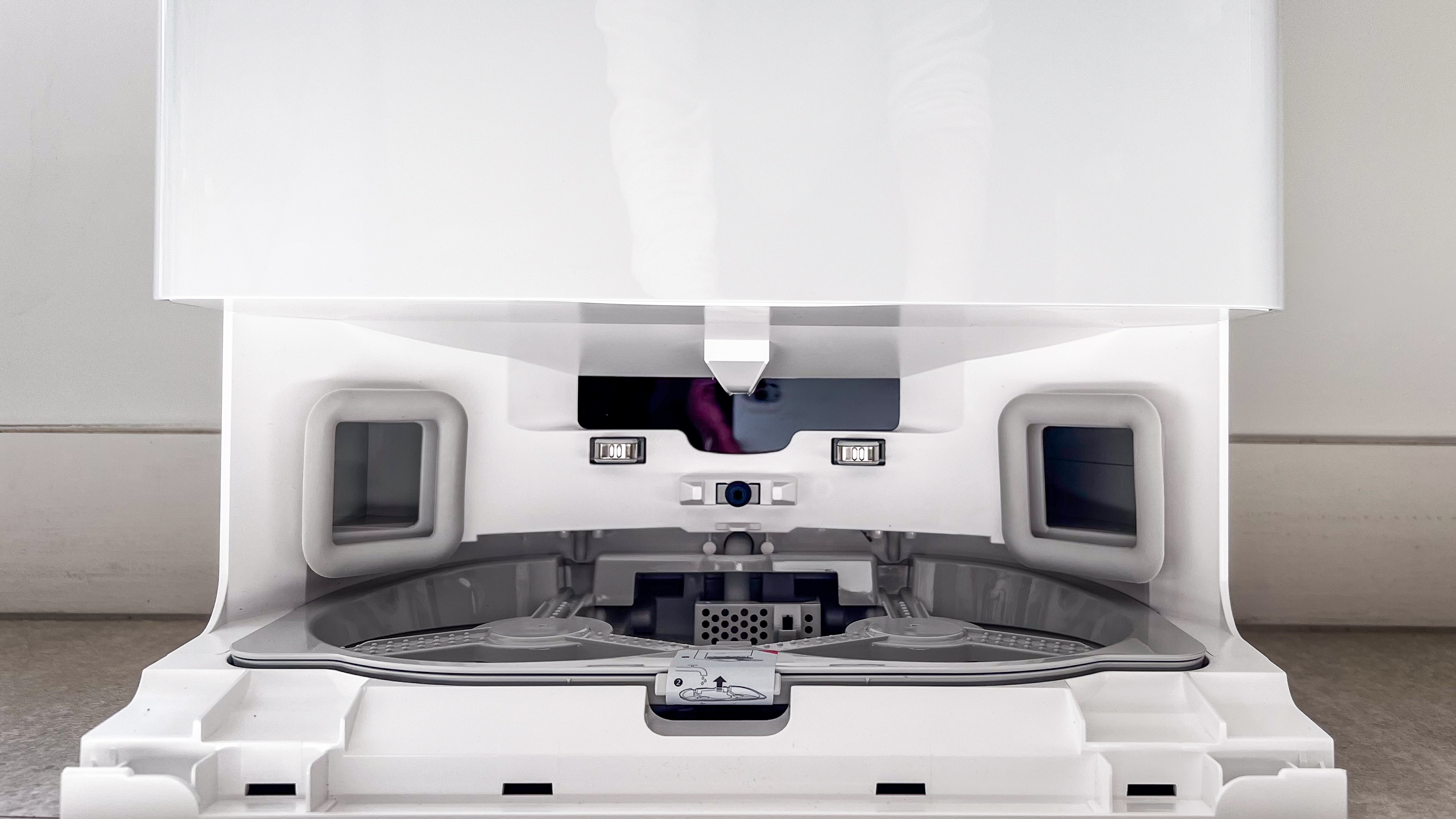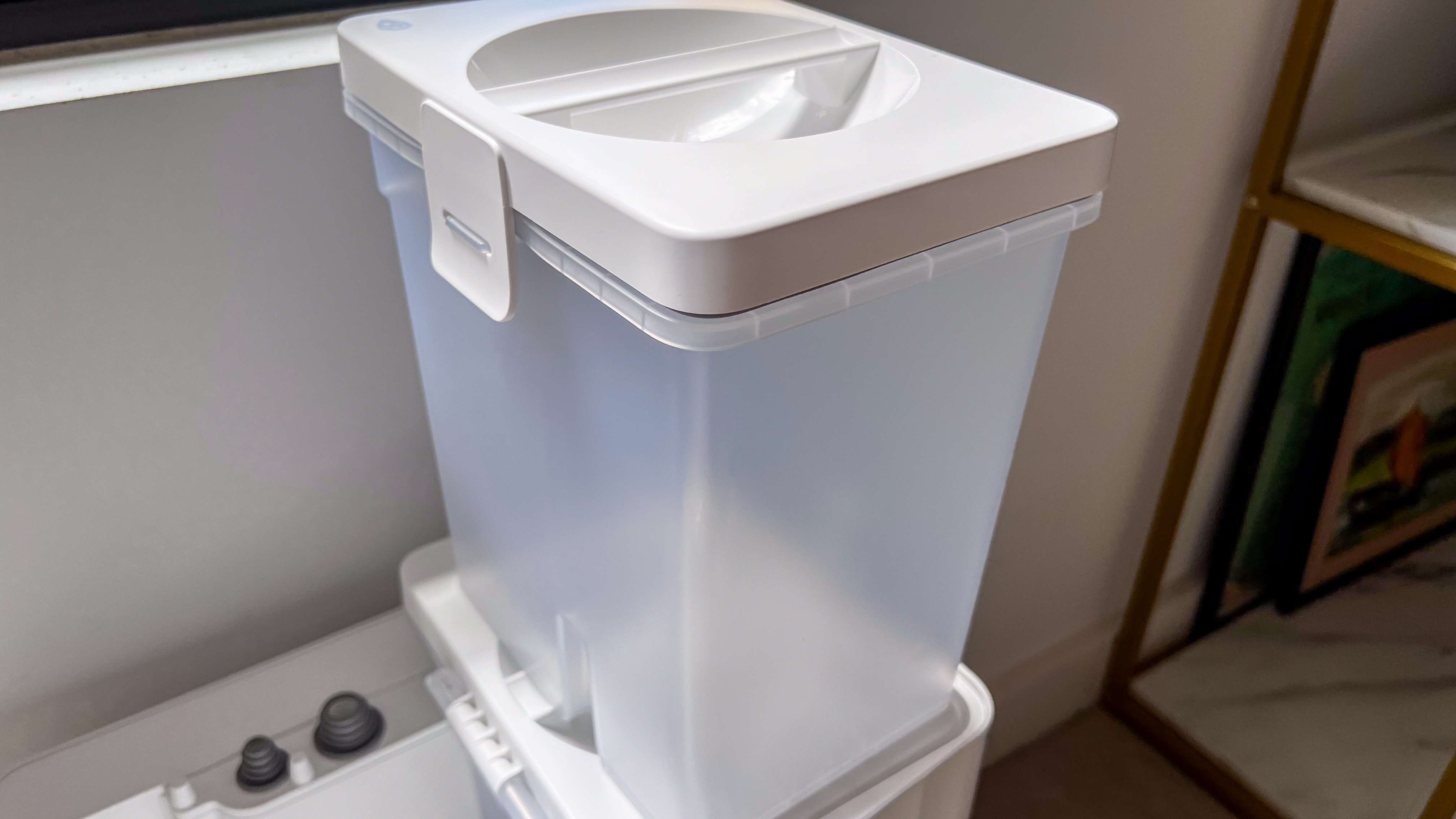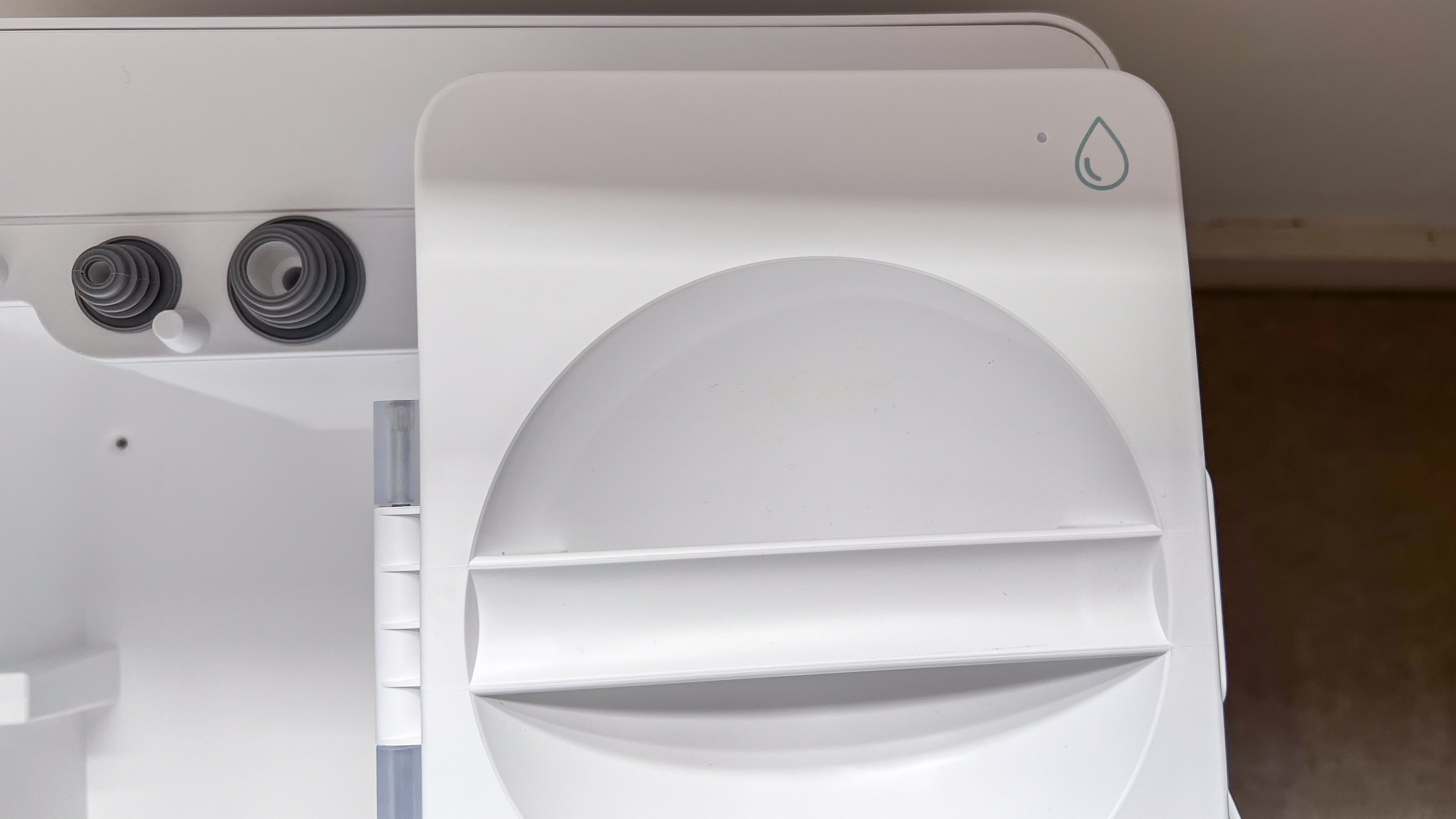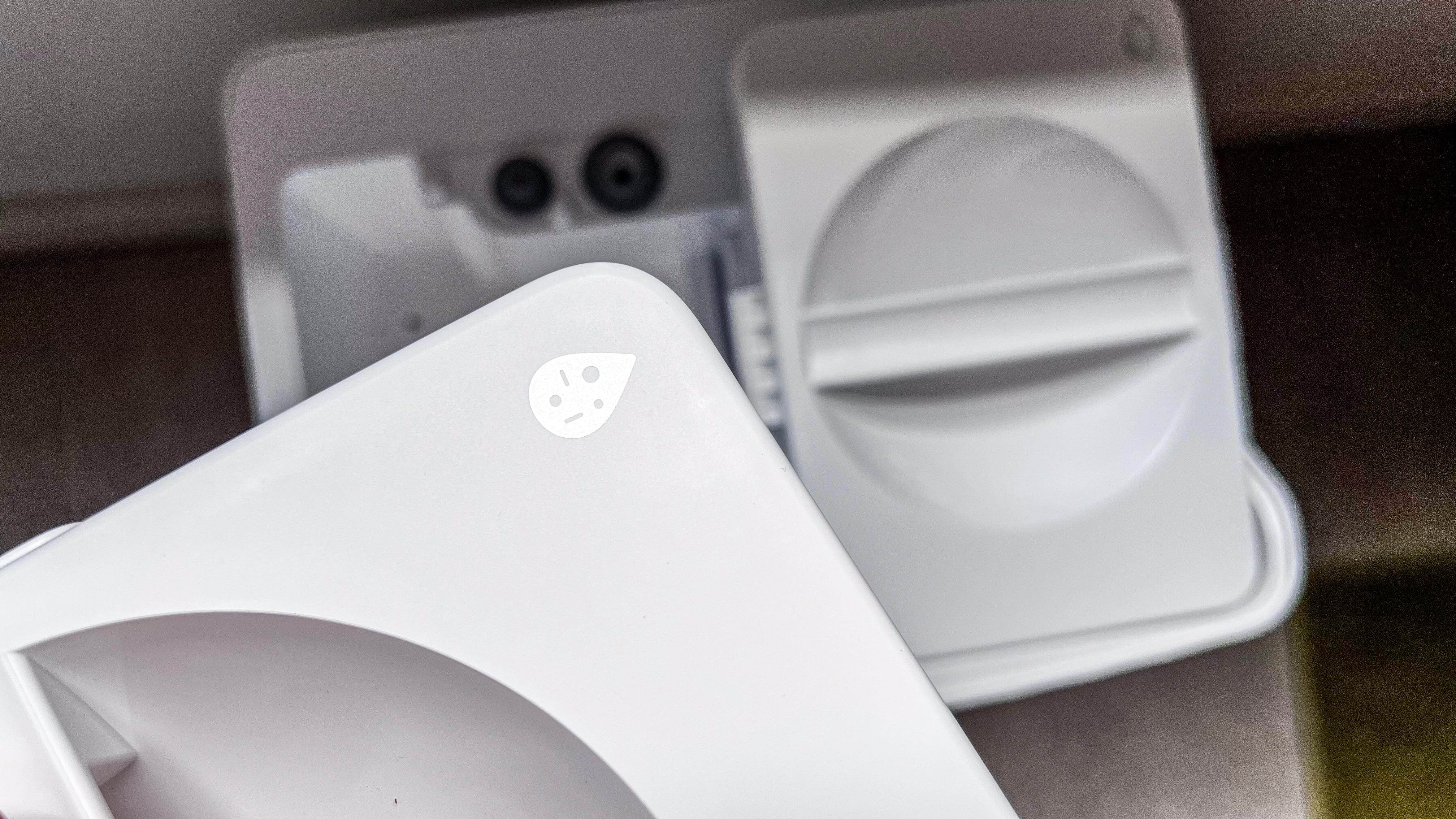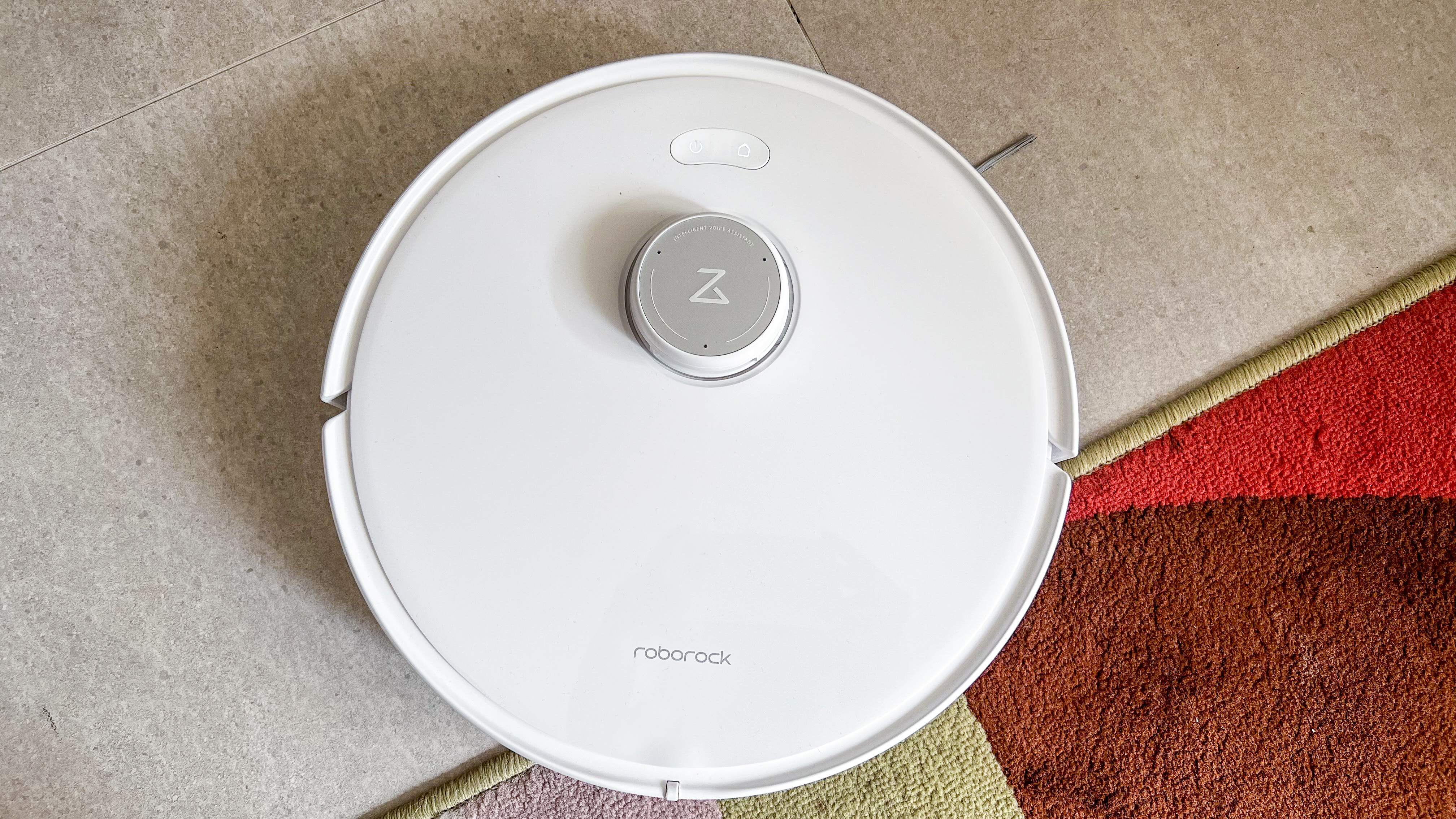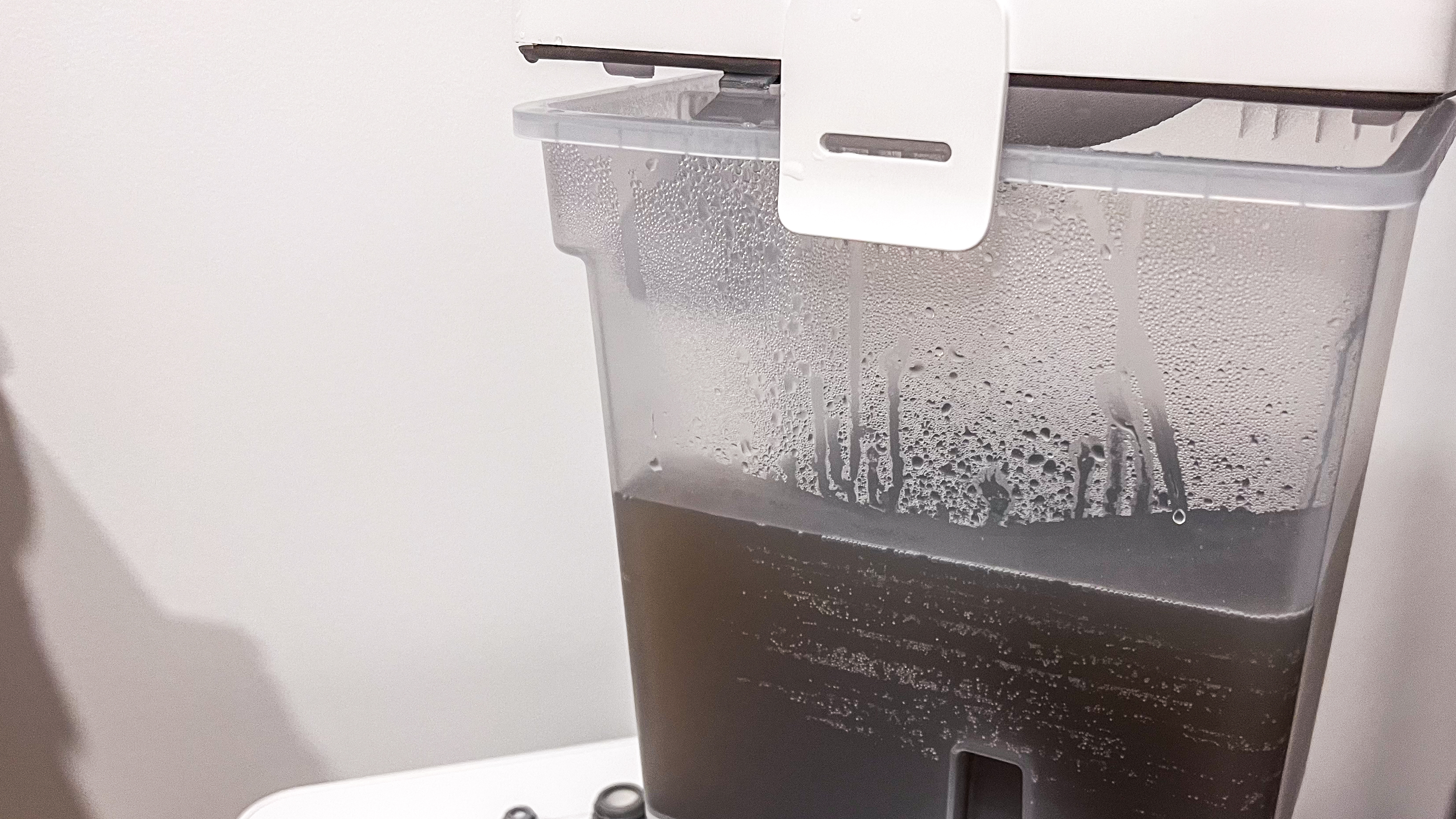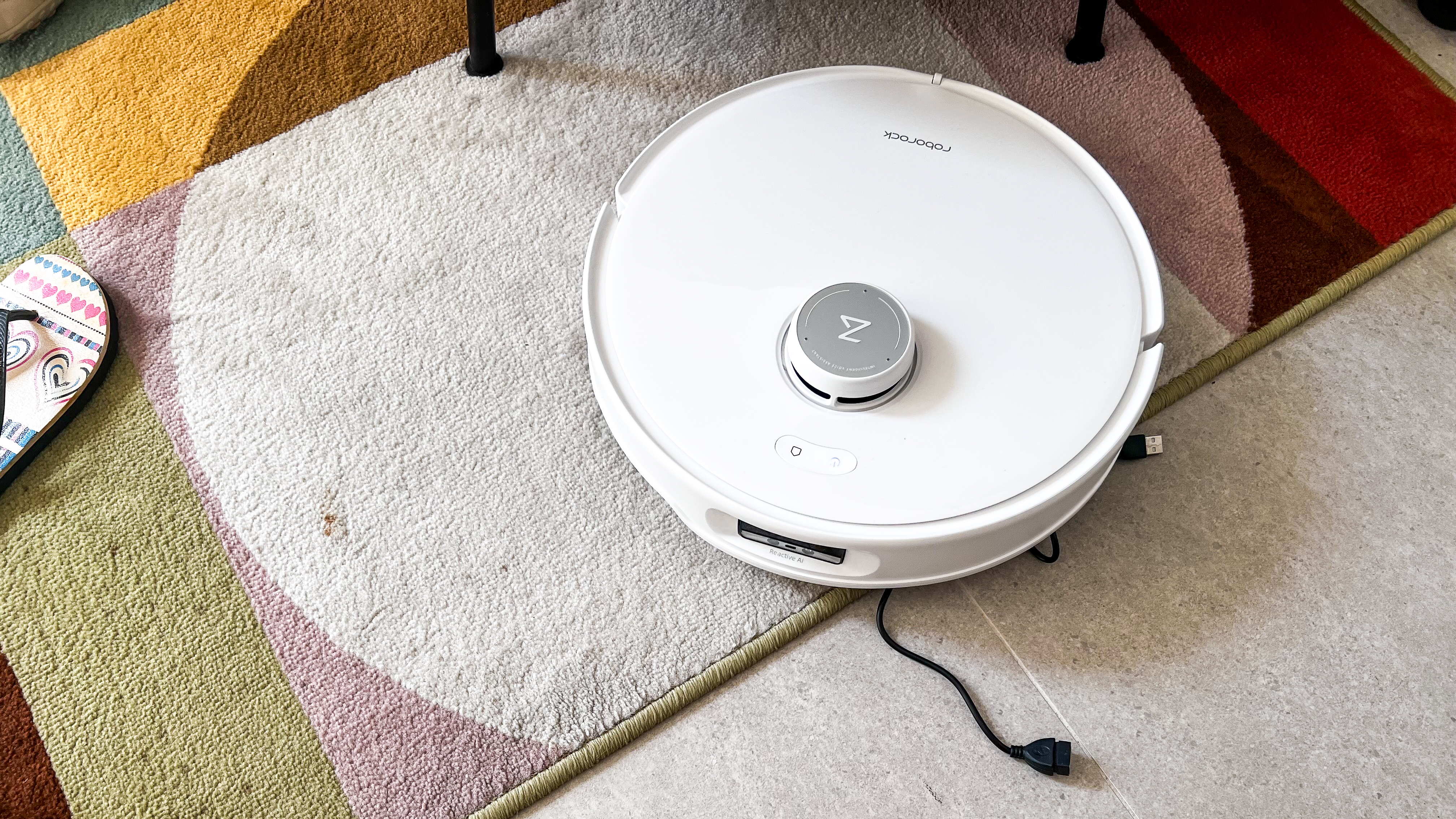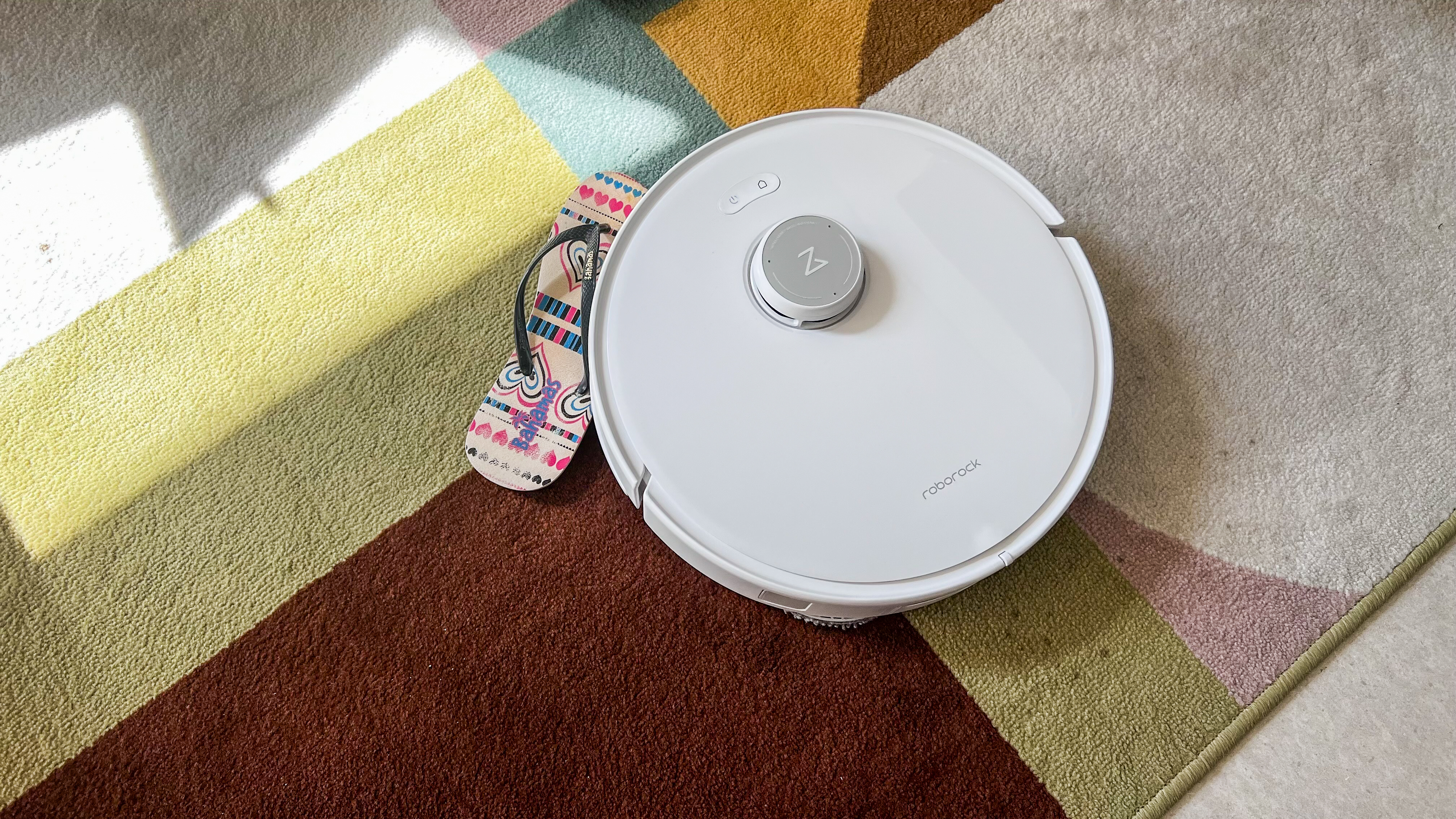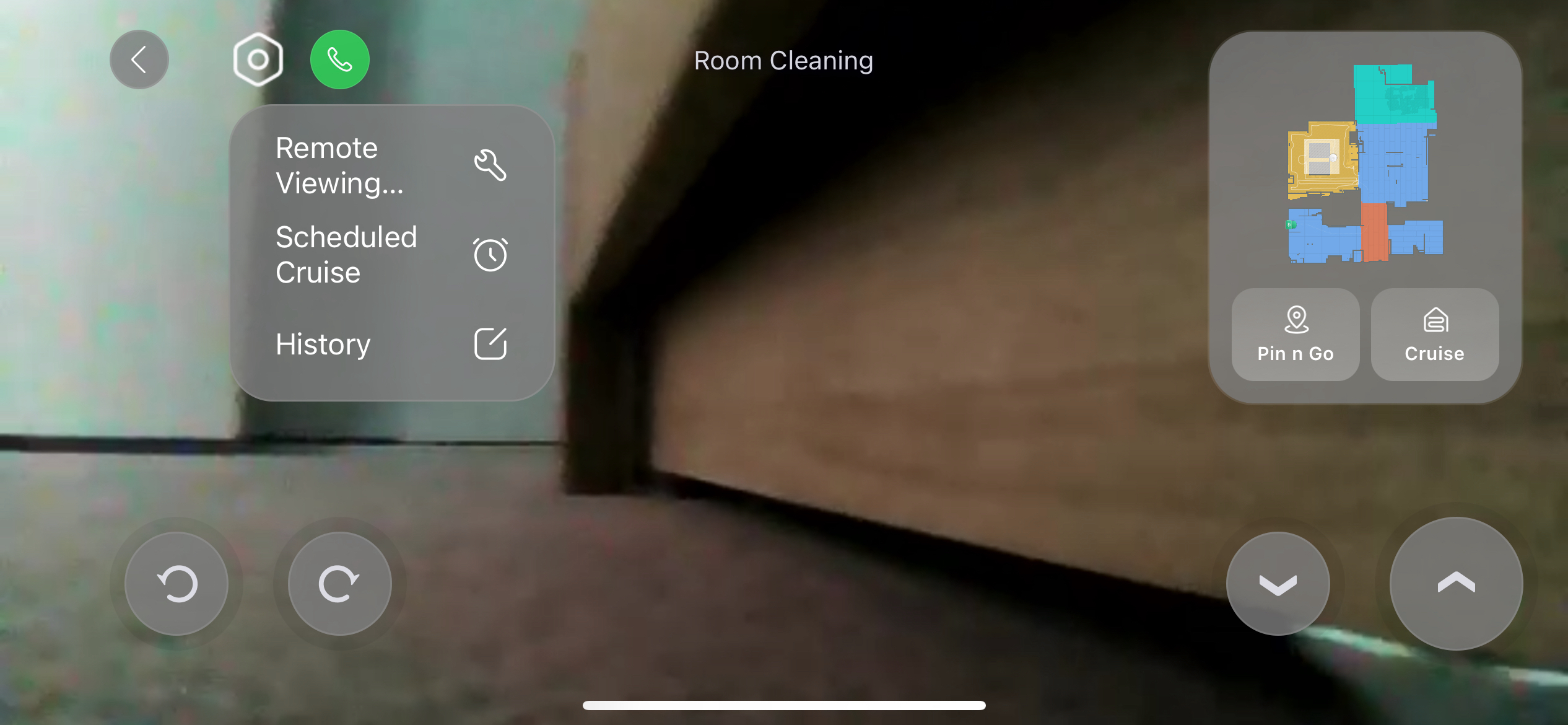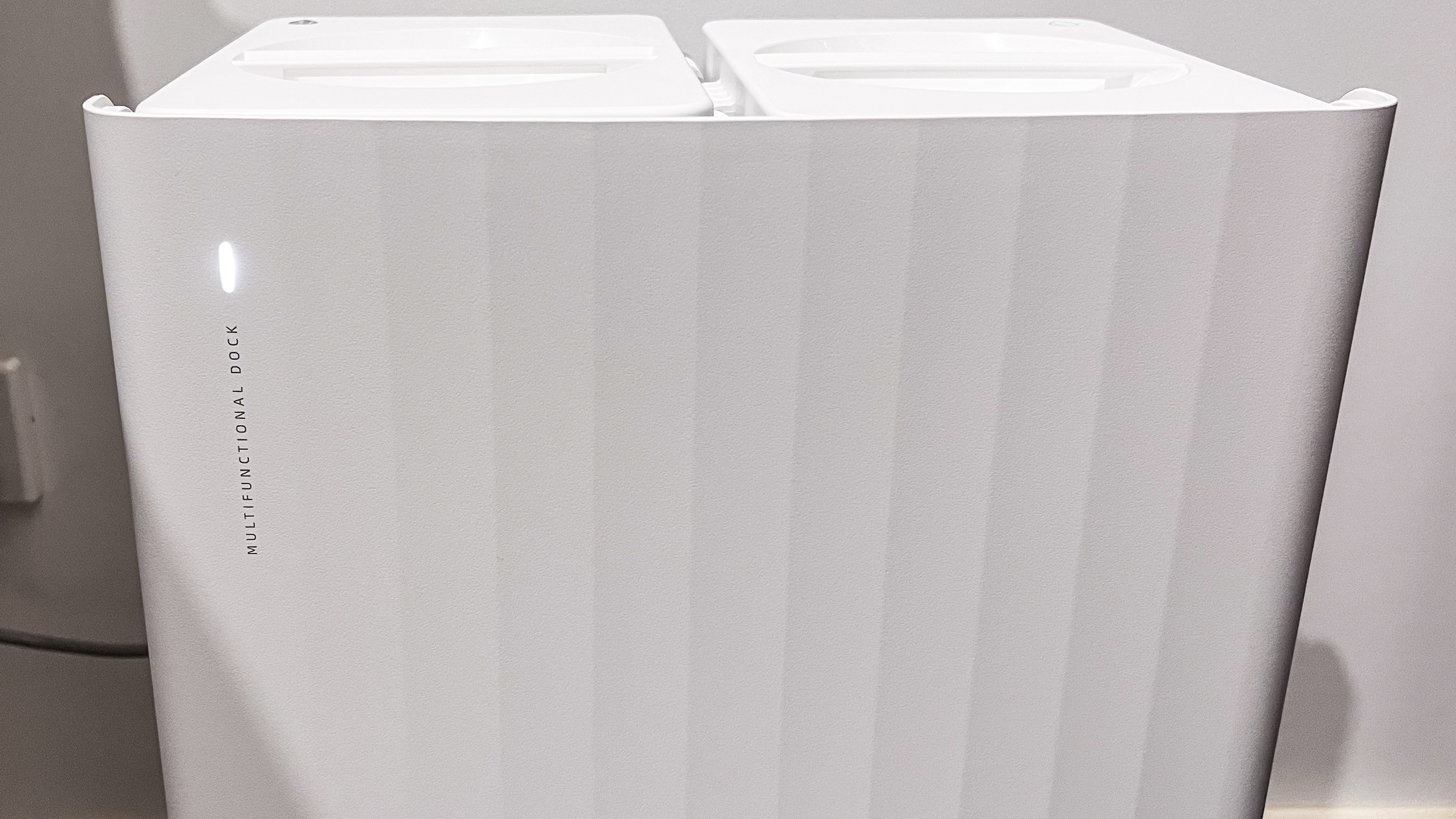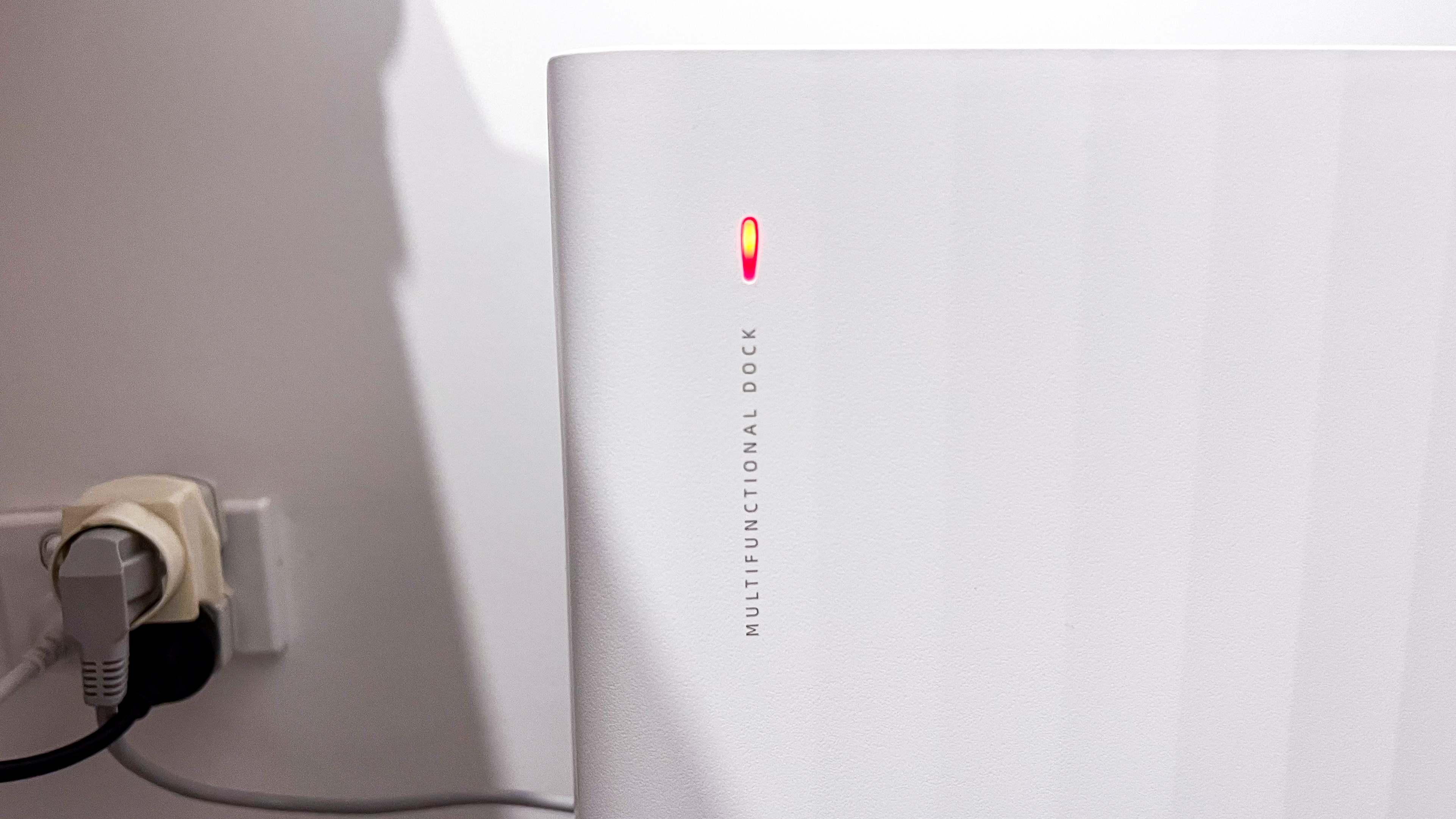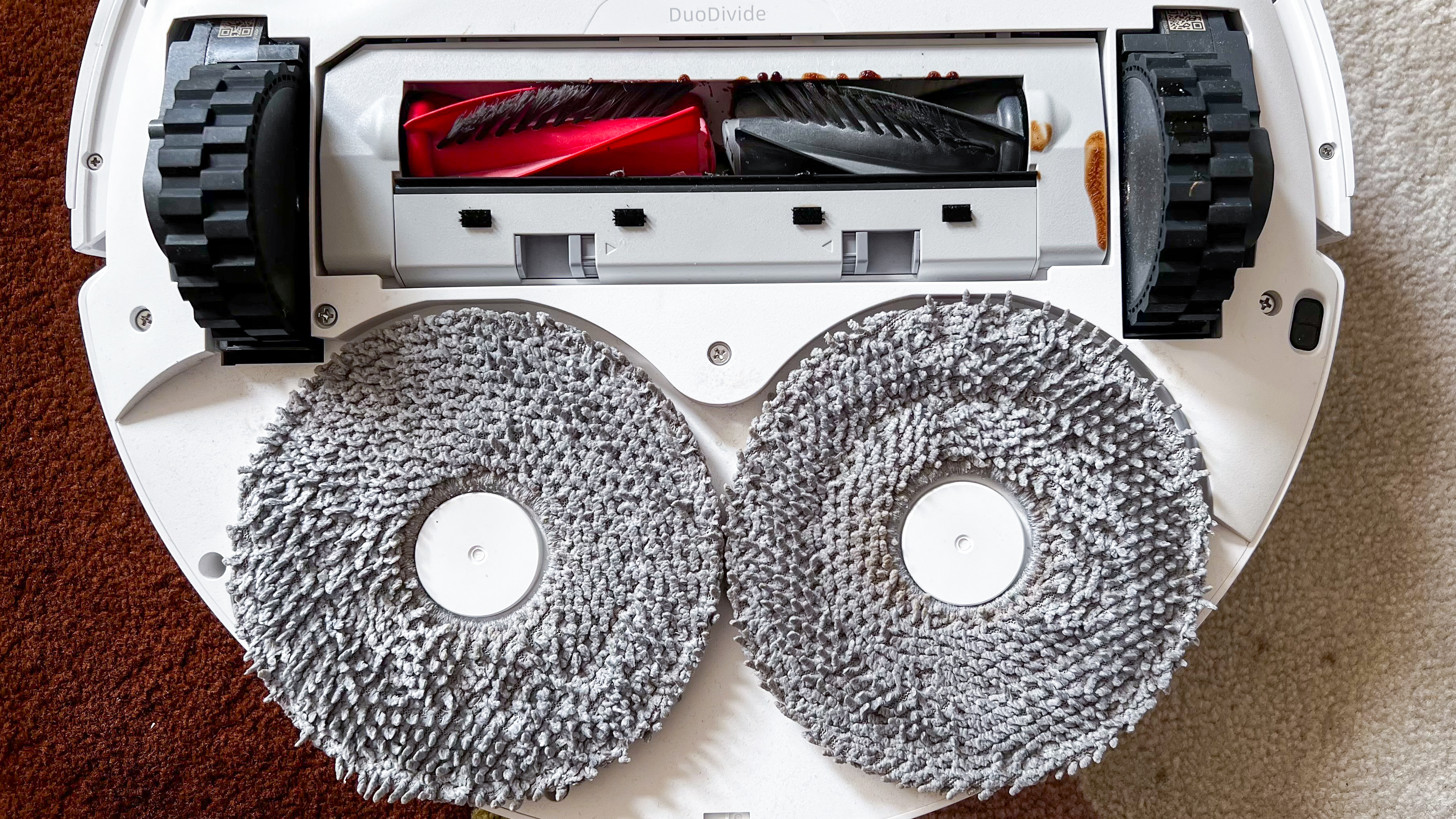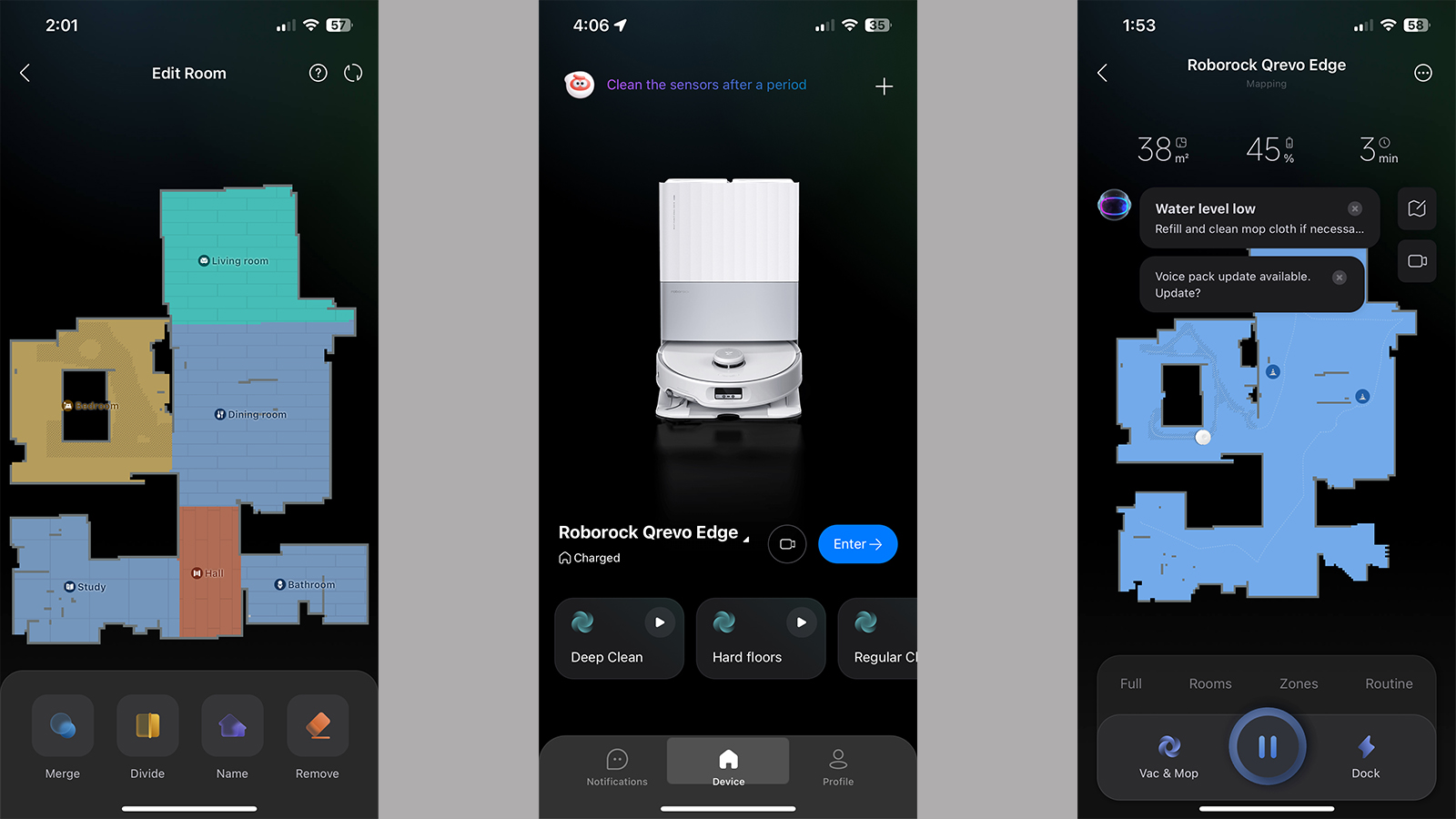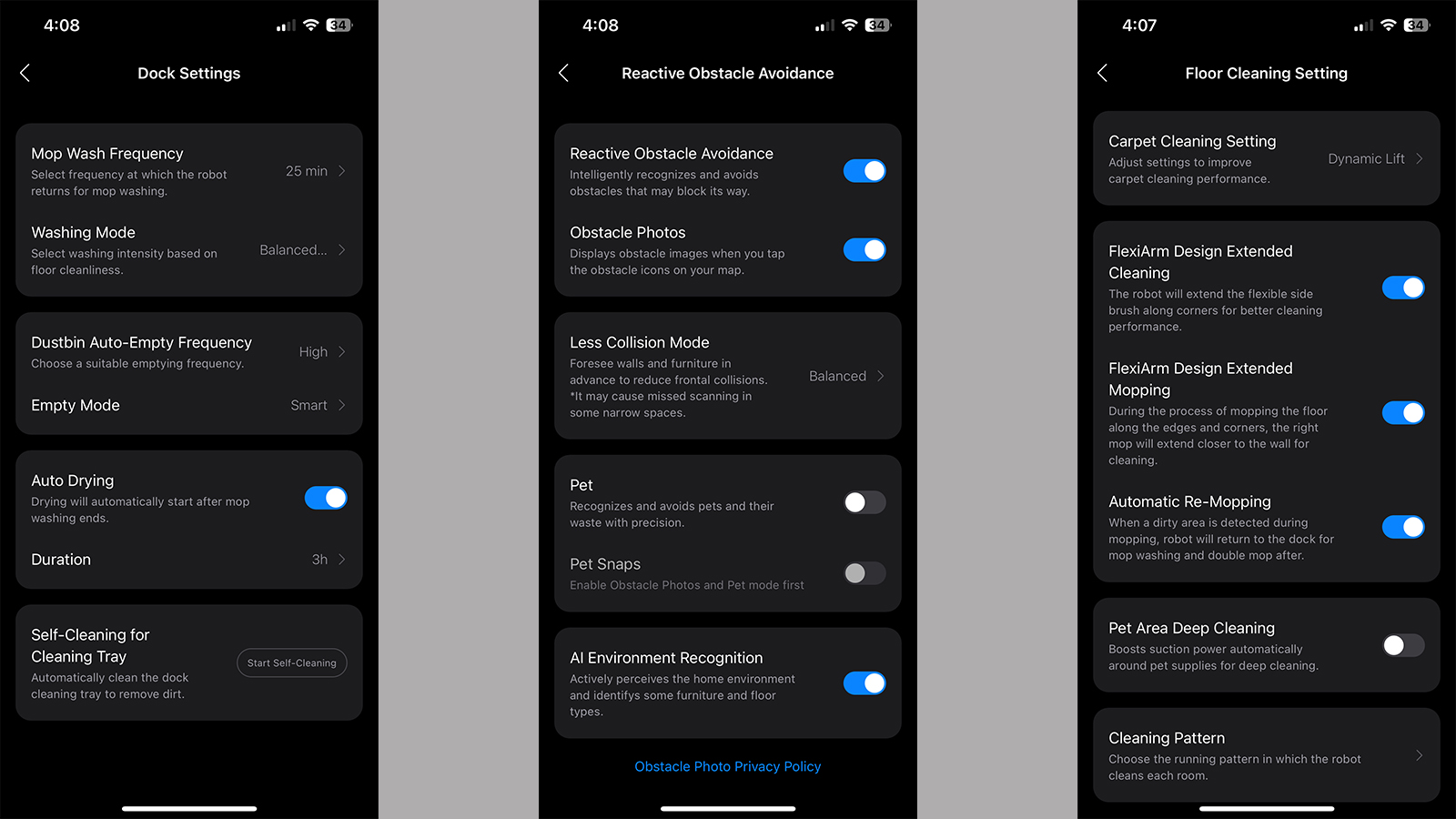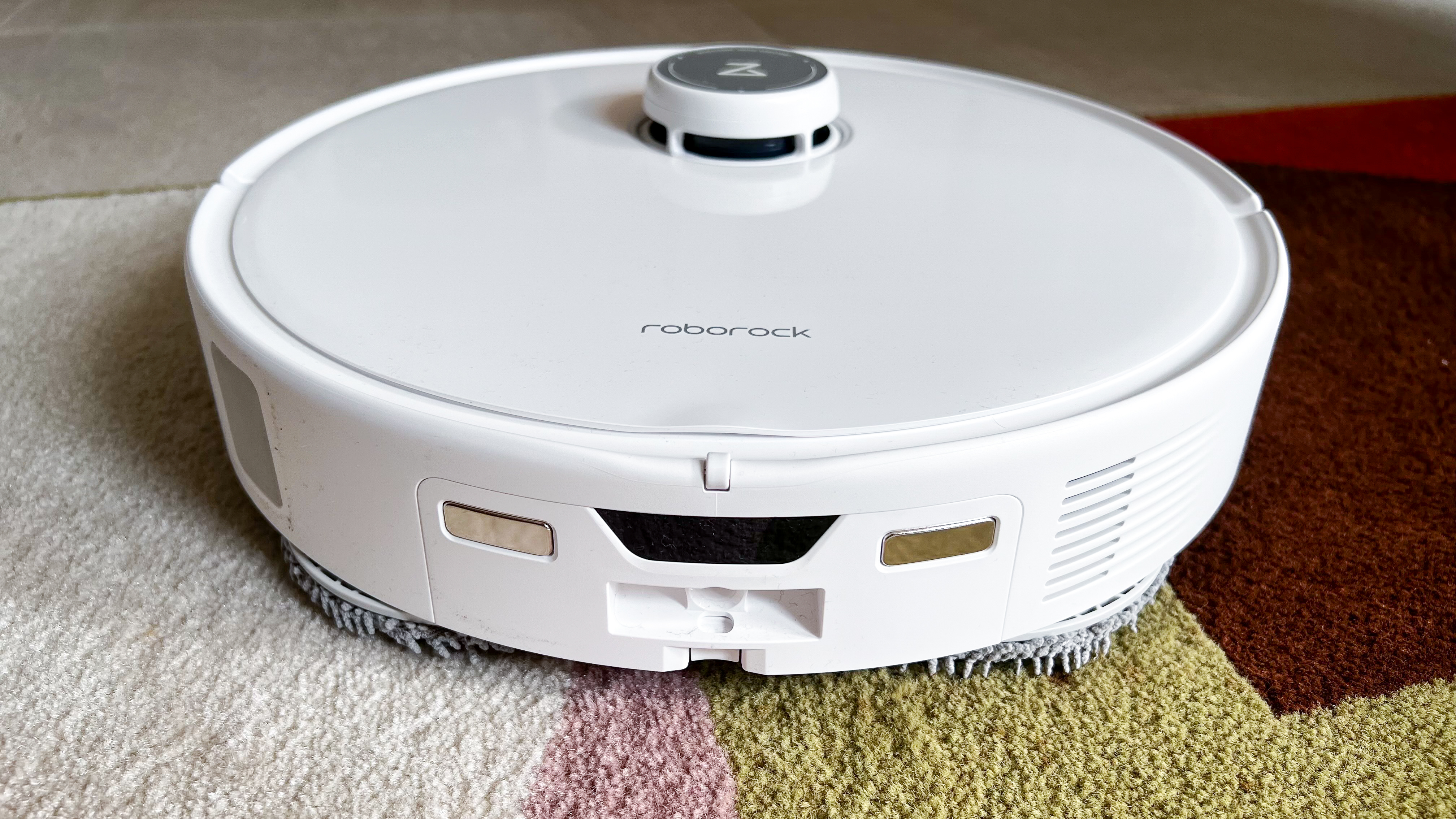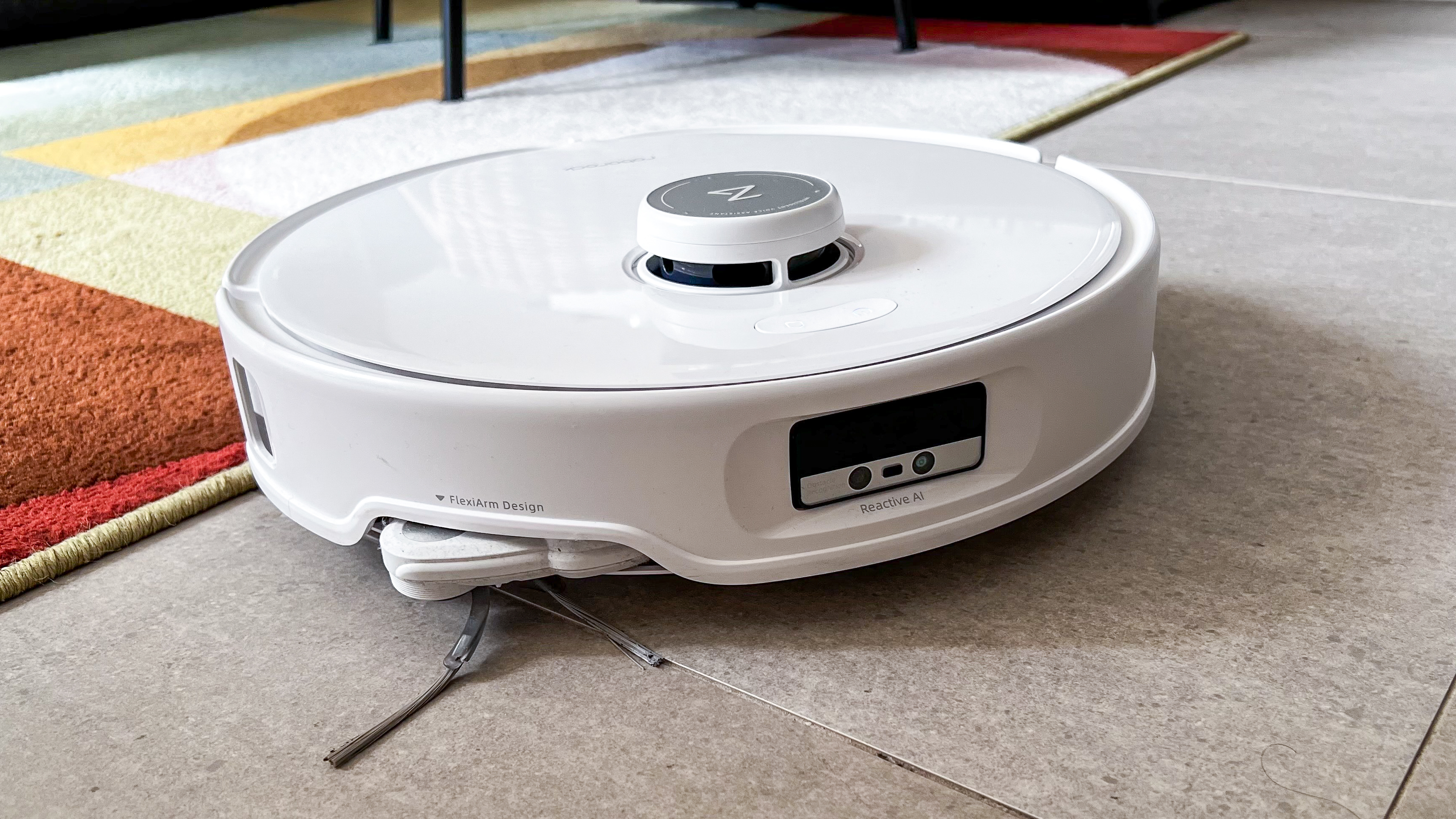Why you can trust TechRadar
We spend hours testing every product or service we review, so you can be sure you’re buying the best. Find out more about how we test.
Roborock Qrevo Edge: Two-minute review
Roborock has been making excellent robot vacuums for a while now, with the Qrevo series stepping it up over the Q and S series bots. With more suction power and a wider feature set compared to older models, the Roborock Qrevo Slim and Roborock Qrevo Curv performed really well in our tests. The Roborock Qrevo Edge joined its siblings in January 2025 and is quite effective at autonomous cleaning… provided you use it for the daily (or regular) cleaning tasks.
It’s essentially the love child of the Curv and the Slim: it uses the exact same technology as the former with an identical bot, but inherits the self-cleaning dock design from the latter. So instead of a curvy dock, it’s a more traditional design that’s simple to set up and use.
It’s a nice-looking dock, but I question its lack of proper sealing. The lid of the dirty-water tank in the unit sent to me for this review had tiny gaps even after being clipped closed and I found that if I didn’t clean it out soon after a mopping run, it would begin to smell.
It’s similar with the dust bag too, wherein I found that it can emit a slight odor when the bin in the bot is being cleaned out automatically. That means you might have to replace the dust bag sooner than necessary which, in turn, will increase the ongoing costs of running the Qrevo Edge.
There’s not a lot to complain about when it comes to the robot vacuum’s cleaning prowess as long as it’s not expected to handle tough spills. There’s 18,500Pa of suction power, which I found to be good enough to clean up a carpet with hair or fur tangled in the fibers, although a few strands always get left behind as robot vacuums are meant as ongoing maintenance cleaners rather than being the primary cleaning appliance.
It’s also quite good at picking up fine powders and slightly larger debris like oats, but it regularly misses room edges. That’s not unique to the Qrevo Edge but, given its name, I was expecting slightly better edge-cleaning performance.
Mopping, too, is also good when it comes to day-to-day cleaning on hard floors and I found it was excellent at sensing the change in floor type to raise its mop pads when necessary. However, despite the extending mop pads, it often missed about an inch along the edges of a room during my testing, and it can spread tough wet spills (like ketchup or milk) across a floor if you aren’t careful with setting up the correct cleaning routine.
Roborock claims that the Qrevo Edge can handle thresholds of up to 4cm, which is true, but it’s worth noting that it takes time to cross over, trying to determine the best angle for it and the amount of power it needs to push itself over.
While it excels at being an effective autonomous cleaner for the daily or regular cleaning tasks – and its SmartPlan feature is a game changer in those circumstances – its inability to tackle tough spills when doing a zone clean and get to room edges consistently makes it hard to recommend at its premium price point.
Roborock Qrevo Edge review: price & availability
- List price: $1,599.99 / AU$2,799 (“coming soon” to the UK)
- Launched: January 2025
- Available: In select markets, with wider availability later in the year
The Qrevo Edge was released a few days before the Roborock Saros 10 series was announced at CES 2025 in January. In fact, the Edge is now part of a duo, with the Qrevo EdgeC joining it in March at a lower price point and with some missing features.
The Roborock Qrevo Edge will set you back $1,599.99 / AU$2,799 in the US and Australia at full price, but it’s already discounted down to $1,299.99 / AU$2,499 when purchased directly from the Roborock online store. Some authorized retailers are also offering the same or a better discount in most markets where it’s already available.
UK pricing and availability is yet to be confirmed, but it’s definitely being added to the Roborock catalogue as it’s listed as “coming soon” on the British website.
Despite the discount, the Qrevo Edge is still an expensive robot vacuum cleaner. That’s exacerbated when you consider that the more powerful Roborock Saros 10 (22,000 Pa suction compared to 18,500 Pa in the Edge) is the same price in the US and AU$200 more in Australia. It costs £1,499.99 in the UK. In fact, the Saros 10 has a retractable LiDAR puck that allows it to go under furniture to clean, potentially making it a better investment.
You will need to consider ongoing costs as well. The dust bag will be the most frequent purchase you make but, at some point, you will need to replace the mop pads too due to wear and tear. These aren’t too expensive as you won’t need to replace them too often (the dust bag has a 2.7L capacity that could last you 2-3 months, depending on use), but if you take into consideration the Roborock detergent for mopping, that will quickly add up.
If you’re after good value, something like the Ecovacs Deebot T30 Omni (or the T30 Pro Omni) would be ideal. It cleans just as well as the Qrevo Edge, if not better, although it lacks some of the features you’ll find on the Roborock. Still, the bang for buck you get from similar models to the Deebot is a lot more.
• Value score: 3.5 out of 5
Roborock Qrevo Edge review: specs
|
Max suction: |
18,500 Pa |
|
Robot diameter: |
13.7 inches / 34.7cm |
|
Robot height: |
4.1 inches / 10.3cm |
|
Dock dimensions (W x D x H): |
19 x 13.3 x 20.5 inches / 48.7 x 34 x 52.1 cm |
|
Onboard dustbin volume: |
325ml |
|
Dust bag volume: |
2.7L |
|
Dock clean-water capacity: |
4L |
|
Dock dirty-water capacity: |
3.5L |
|
Base type: |
Charge, self-empty, refill water, wash mop pads, clean and dry mop pads, dispense detergent, self-clean |
|
Max threshold clearance: |
1.6 inches / 4cm |
Roborock Qrevo Edge review: design
- Sleek, modern dock
- Easy to set up, but may require frequent cleaning
- Extending side mop and brush, anti-tangle split main roller
The Roborock Qrevo Edge’s design isn’t particularly standout – it’s nothing we haven’t seen before – however, its white body (dock and robot) makes it look sleeker than its actual footprint would suggest.
The robot is of a similar size to other models, and the dock’s tray – where it sits to get cleaned and recharge – barely extends out beyond its radius, giving the impression of not taking up too much space.
It’s quite a tall dock though, so you may not be able to tuck it under a countertop or kitchen island, like you can with the Ecovacs Deebot T30 Omni, and you’ll need a good amount of clearance to lift the two tanks out of the dock. So it’s going to need a little open space around it.
Robot design
The bot in particular will be very familiar to anyone who’s ever seen a robovac before, let alone used one. The most obvious feature on the circular robot is the puck-like LiDAR housing on the top. The puck has the Roborock logo in a silver-grey color that adds a touch of class.
Also on top is a magnetic cover to keep the 325ml onboard dustbin out of sight, with cutouts for the LiDAR puck and two buttons. You won’t need to access the dustbin much – only to clean the filter every once in a while or if the self-empty function fails. Even the buttons need to be used sparingly.
On the front there’s a camera and additional navigation elements. You can use the camera to run security checks while you’re away or look in on your pets remotely. There’s also a light on the front that comes on automatically if the robot is cleaning in a dark area or room.
A semicircular bumper protects the front, and it’s got just enough give to absorb bumps into furniture and larger obstacles.
The undercarriage has a lot going on. Two large wheels catch your attention first and these help the Qrevo Edge traverse thresholds of up to 4cm high. Roborock calls this AdaptiLift, which has been inherited from the Curv and found its way into the newer Saros 10 as well. There’s also a smaller wheel towards the front of the robot for better maneuverability.
The main roller brush is quite unlike any other I’ve seen before. Instead of being a single bar, it’s made up of two pieces and split in the middle. Both halves have bristles and fins and, to avoid getting hair and fur tangled in said bristles, Roborock says the split design helps strands get pushed to the middle from where they’re sucked into the bin.
There’s also a spinning side brush and, again, it’s designed differently to what’s commonly seen on other brands. The brush has only two sets of long bristles (compared to the usual three), both curved to avoid hair entanglements and push dirt and debris towards the main roller.
The arm that the brush is affixed to can extend outward to give the bristles a longer reach. Roborock calls this FlexiArm technology and it’s also used to extend the mop pads as well.
Again, it’s a familiar design for the mops – two circular pads attached to the plates via some seriously strong Velcro. During my testing I found that the pads extend out individually, never both at the same time as I’ve seen on other brands, and both can be raised 10mm to avoid medium and high-pile carpets from getting wet.
Unlike other premium models like the Dreame X40 Ultra, the mops don’t detach if you want a vacuum-only run.
There is, of course, a small water reservoir tucked away somewhere inside the robot, but the design is such that you can’t see it at all. It gets filled automatically from the clean-water tank in the dock every time the bot needs to do a mopping session.
Dock design
Like many other premium all-in-one robot vacuums, the Qrevo Edge’s self-cleaning dock is a do-it-all pit stop.
It houses two water tanks inside which can be pulled up from the top. They’re both marked by different silver drops on a corner of their lids to differentiate them – one for clean water, the other collects dirty mop water.
Both look identical, but closer inspection reveals a small difference in shape, which allows the clean-water tank to have a larger capacity of 4L compared to 3.5L of dirty water. That’s quite a bit and should allow for two mopping runs of an average two-bedroom home, if not more.
The tanks close via a hinged lid that clips into place, but the seal isn’t as good as I’ve seen in other all-in-one robovac models. This allowed a bit of nasty odor to escape when I forgot to clean out the dirty water after one cleaning session, meaning you might want to ensure the left-hand tank is washed out as soon as possible.
Below the water tanks is a covered nook for the dust bag. The cover comes off very easily and replacing the bag is also just as easy.
As with other all-in-ones, the base tray that the robot sits on has ridged sides, which allows the mop pads to be scrubbed when they’re being washed. Not only can the dock refill the bot’s onboard water reservoir, empty the bin, wash the mop pads with hot water (167ºF / 75ºC), then dry them with warm air (113ºF / 45ºC), but it can also self-clean that tray.
Overall build quality isn’t too bad, but the lids on the water tanks not closing properly takes away from the premium-ness of the whole design. Moreover, the plastic dock – which isn’t uncommon at all – just doesn’t quite exude oomph despite the silver details. It’s not that it looks cheap, it just doesn’t look… well, premium.
• Design score: 4 out of 5
Roborock Qrevo Edge review: performance
- Excellent vacuuming on higher settings; can handle tangled hair in carpet fibers
- Mopping also very good on higher settings, but regularly misses edges
- SmartPlan is efficient in terms of navigation and battery life, but the automated cleaning may not suffice
If there’s one thing Roborock does well, it’s providing an easy setup for its robot vacuums. My colleagues have said previously that they’ve not faced any setup issues with other models from the brand and it was the same here. In fact, you don’t even need the manual to get you started, it’s all quite intuitive.
As soon as the robovac was connected to my Wi-Fi network, I checked how much battery it had and immediately sent it off on its initial mapping run. This took just six minutes to complete in a test space measuring approximately 40sqm and containing a carpeted bedroom and tiles in the rest of the apartment.
The initial map was quite accurate in the layout of the test space, and I was then able to edit the rooms: adding furniture and dividing up open-plan spaces into their correct assigned names.
The test space was single-storey, so I wasn’t able to see how well the cliff sensors function. It also had no pets, so I can’t comment on how well the Qrevo Edge’s pet avoidance features work, but I conducted all the other standard TechRadar tests to see how it held up.
Vacuuming
The Qrevo Edge’s 18,500 Pa suction power shows itself off quite well when it comes to its vacuuming prowess. I found it very hard to fault it, even when on lower suction settings – albeit on hard floors that aren’t too dirty. The higher suction options are very effective on carpets, even those with entangled hair within the fibers.
As with other Qrevo machines, there are five power levels to choose from: Quiet, Balanced, Turbo, Max and Max+. Importantly, the app allows you to choose from just a single vacuum-only run or two, meaning it can take on some tough jobs.
As good as the Qrevo Edge is at vacuuming, I do have to note that you shouldn’t expect perfection. I found that hair on carpets are mostly sucked up – say about 98% of the strands – but some will remain. This is more so if you happen to have hair, fur or dirt along the edges of a carpeted room as the side brush just doesn’t have the force to gather these up and pull them towards the central roller.
The proof is usually in the pudding and when I looked at how much dirt the Qrevo Edge collected after its first vacuum-only run (done at the Max+ setting) in a single carpeted room, I was impressed that its higher suction did a far superior job than the 11,000 Pa Ecovacs Deebot T30 Omni that it replaced in my home.
Even the Turbo and Max modes do a good job on carpets, provided you don’t have pets shedding on them copiously – they’re effective for the usual dust-sucking chores. And I had no issues with tangled hair on the main roller brush.
To test how well the Qrevo Edge can handle other kinds of dirt and debris, I conducted TechRadar’s standard tests by sprinkling some oats, tea dust (from a teabag) and tea leaves onto a mid-pile carpet.
I first set the Qrevo Edge to do just a Zone clean for the carpet only, which defaults to the SmartPlan setting wherein the bot chooses its own suction mode depending on floor type. As you can see from the video clip below, it does a pretty good job, although its navigation in this mode is a little erratic.
While all the oats and tea leaves were cleaned up, I could see some tea dust still on the carpet. As a comparison, I sprinkled a little more dust from a teabag and used my Dyson V15s Detect Submarine in Auto mode to clean it up and saw similar results. I repeated the tea dust test with the Qrevo Edge on the carpet in Max+ mode and found no reason to complain.
It’s a different story on hard floors though. For the exact same test performed on tiles, I found that the side brush scattered the larger debris (oats) when doing a Zone clean on the default SmartPlan settings. The scattering happens on all other settings, but when changed to doing a 2x vacuum at Max, it did a better job.
Where it fails quite badly is edge cleaning. I expected most of the tea dust I had scattered along a room edge on a hard floor to be picked up, but sadly that wasn’t the case. Even running it on a 2x vacuum-only run at Max+ made no difference. I had to use the crevice tool on my Dyson to clean up the tea dust remaining on the floor.
Moreover, if you have gaps between tiles or wood panels on your floor, fine dust will invariably get moved into the grouting or the gaps and even the Max+ setting does nothing to clean that up. Larger debris getting caught in those spots, though, will get cleaned, provided you use the maximum suction setting.
To be fair to the Qrevo Edge, though, robot vacuums weren’t designed to be your primary cleaner, but rather for ongoing day-to-day or regular cleans. You’ll still want to have one of the best vacuum cleaners on hand for the more difficult jobs, particularly for carpets and sucking up dirt from nooks and crannies.
Mopping
Like its vacuuming prowess, the Qrevo Edge does a good job of mopping too – again, only if it’s not taxed by too many spills. The regular cleaning jobs of dusty footprints and spilt water is excellent.
This mopping performance is helped by four water-flow levels – Low, Medium, High and Custom/Gentle. I found the Low and Medium weren’t very effective for the kind of tiles I had in my test space, as the pads didn’t saturate enough for my needs and barely dampened the floor. While this is excellent for sensitive floor types (like some wood panels), the High setting was perfect for me and that’s what I left it at for the various Routines I set up via the app.
The Custom setting, while allowing you to choose the water-flow level, doesn’t ‘scrub’ as well as the other three and that, again, is good for sensitive floor types. If you do need a better clean, you can set the robot to sense areas of excessive dirt and it will automatically return to do a second mop after it has washed the pads following the first attempt. During my testing, though, this feature failed most of the time.
Depending on your cleaning needs, you can set the bot to mop-only, vacuum then mop, or do both at once. Personally, I’m not fond of the last option as I’m a little paranoid that the mop pads will pick up more dirt and won’t get washed properly.
I found that it was also a good idea to assign the order in which it cleans rooms as this can reduce track marks from its own wheels over an area it has just mopped – this can be done in the app by just editing the saved map.
Like I did for vacuuming, I performed a couple of mopping tests to see how well the Qrevo Edge does.
While we usually use ketchup in our standard mopping test, I had none at the time and used oyster sauce instead. I allowed a small spill to dry out a little, but also plopped some of the fresh viscous liquid on another part of the floor to test the scrubbing action on dry and wet messes.
Even with the water-flow rate set at High, the Qrevo Edge had minimal effect on the dried-out sauce on the Standard ‘route’. The route is how the robot moves through a space while cleaning and there are four options for both vacuuming and mopping. After setting the robot to do a 2x mop run in the Deep+ ‘route’ setting, though, most of the dried oyster sauce was cleaned, but not fully. I ended up wiping that spot myself.
Cleaning up a wet spill was another matter altogether. On a default Zone run (which uses the SmartPlan option), the sauce was mopped but, of course, got stuck on the side brush (I’m glad I was able to rinse it), smeared the undercarriage and the mop pads left long, brown streaks as the bot moved on.
After allowing it to go back to the dock for a mop wash, I immediately set the Qrevo Edge to a 2x mop at the High water setting to clean up the remaining mess, which it did well.
I’d expect situations like these are extreme and most users wouldn’t allow their robot vacuum to encounter such messes, but it’s worth noting that it doesn’t handle bigger dry messes well either. For example, I sprinkled copious amounts of talcum powder on a wet bathroom floor, then allowed that to dry completely. On a High water-flow setting, white streaks were left on the bathroom floor, much like the oyster sauce.
While I can’t fault the Qrevo Edge’s mopping issues as it’s not unique to it, I regularly found that it didn’t go all the way to the edge of a room despite the extended mop pads. More often than not, about an inch of floor space along skirting boards would remain unmopped. And that was disappointing, particularly since this robot vacuum comes at such a high price and, conspicuously, has ‘Edge’ in its name.
Navigation and obstacle avoidance
For a day-to-day regular cleaning run, I found the Qrevo Edge’s navigation to be impeccable. There are two Routes (or paths) you can select in the app when it’s vacuuming or vacuuming and mopping at once – Fast and Standard – but you’re provided four when you opt for mop only – Fast, Standard, Deep and Deep+. These Routes determine how much of the floor gets covered and, after testing all of them, I found that the Qrevo Edge follows the chosen Route correctly.
The Route you opt for will, of course, affect battery life and the app gives you a warning every time you change navigation. Despite that, I personally preferred the Standard (for vacuuming) and Deep for mopping as the results were the best.
Importantly, selecting a 2x cleaning run will automatically prompt the Qrevo Edge to clean in the opposite directions for the two sessions, which I thought resulted in even better results than a single Deep mopping session.
The only time navigation was erratic was if I had chosen a Zone clean for a quick session, which defaults to the SmartPlan navigation. This uses deep learning to determine which part of the zone or room the Qrevo Edge should clean first and I found its movements weren’t as precise on a carpet. It was slightly better on hard floors though.
Still, the SmartPlan navigation is quite efficient. Having learned that there is a medium-pile rug in my living room, for example, the Qrevo Edge always did a vacuum-only clean first on the rug, then went back to the dock to wash its mop pads to clean the rest of the tiled living-room floor. On the rug, though, it wouldn’t always move in straight lines, but I didn’t see that it missed any spots.
The Qrevo Edge’s obstacle avoidance could be better though. While it manages to identify some obstacles in its path and place a marker on the map, this functionality wasn’t consistent. To test this further, I placed its own packing box in its path once and it didn’t add a marker on the map, but it did so for a chair I had moved from its original location.
To check its effectiveness avoiding smaller objects, I ran the standard TechRadar tests of placing a cable, a sock, a slipper (aka flip-flop or thong, depending on which part of the world you live in) and a shoe in the robot’s path.
It nearly swallowed the little sock, which got stuck on the central roller, and because of the sock taking up space on the undercarriage, it ran over the cable without getting entangled. The first time it encountered the slipper, it went over it, but the subsequent times it just pushed the lightweight rubber footwear along in front of it. The shoe was the only obstacle it managed to avoid each time it encountered it on its path.
This shouldn’t come as a surprise though as most robot vacuums have difficulty with the smaller obstacles and would chew up a slim charging cable or a sock. That’s why all brands recommend you pick up the smaller items before you do a cleaning run.
That said, Roborock does call out the Qrevo Edge’s obstacle avoidance, so I expected more. It’s perfectly fine for general cleaning, but the performance doesn’t quite match its high price tag.
The robot can use its onboard camera to take a picture of the obstacle and, when you tap on the corresponding marker (if any) on the map in the app, it will come up. Every time I wanted to try this feature with a specific obstacle, it didn’t place a marker on the map. The only time it worked was for a chair that is permanently a part of the map.
Dock performance
Other than the bit of bad odor I could smell when I hadn’t cleaned out the dirty water the day of the cleaning run, I can’t fault the dock’s performance. There’s plenty of suction that pulls out nearly every bit of dust, debris and hair from within the onboard dustbin.
The only thing I found in the bin after a self-empty was a thin film of fine dust along the sides, which is perfectly normal and can be washed out. Just be sure to fully dry out the bin before placing it back into the robot again.
Even the washing seems adequate. At the time of writing, I’d used the Qrevo Edge for two months, running it a couple of times a week, and the mop pads still look good to me. That said, I found the mop pads looked a lot better after three months of using the Ecovacs Deebot T30 Omni, and I also found the air drying to be more effective in the competition as it uses hot air rather than warm as in the Qrevo Edge.
This means the mop pads take longer to dry on the latter and, if there’s not a lot of ventilation in the area you’ve positioned the robot vacuum, you could smell the pads if there’s even a little dampness left. During my testing, I had to increase the air-drying time to eliminate any smells.
Another indicator of how well the mop washing works is the color of the dirty water in the tank – it was always dark brown, even if I ran the robot on subsequent days, thinking the floor wouldn’t be too dirty. Boy, was I wrong.
The dock’s self-cleaning features also includes one for the tray the robot sits on (and uses to scrub the mop pads). That can get grimy too and the 5-minute self-cleaning session means you need the least amount of work to maintain this machine.
Battery life
Battery life is where the Qrevo Edge truly shines. It’s got a 6,400mAh pack that easily did a full clean session on Max suction and Standard/High mop (on a vacuum-and-mop run) in one go in my test space and still usually had about 36% battery left.
If I set the robot to do 2x cleans at its highest settings, then it would run down to about 12% battery, head back to the dock for about three hours, top up till about 48% and finish the rest of its cleaning. That’s an impressive battery performance in my books considering it was doing power-intensive sessions.
Roborock says that the Qrevo Edge is capable of fast charging (up to 30% quicker than previous models apparently), but I saw no evidence of that during my testing. Considering it took about three hours to get just 40% topped up during my testing, I think the best time to run these kinds of modes is when you’re away for the day – that way, you can return to a clean home and not get impatient with half a job done.
• Performance score: 3.5 out of 5
Roborock Qrevo Edge review: app
- Very detailed app as compared to some of the competition
- Offers plenty of precise control
- Matches system dark mode that looks very classy
The Roborock app is arguably the best-designed I’ve used for a robot vacuum cleaner. When you first download it, it will ask if you want it to match your phone’s system settings, which means it will automatically convert into dark mode and I found that it looks very nice indeed – colors pop and everything is clearly laid out.
It will take time to get used to the app, though, but that’s only because there’s a lot going on. In fact, I kept discovering quirks and better ways to use the robot all through my two-month testing period. While my test space was a single-storey home, the Roborock allows you to save multiple floor maps and swap between them, although you will have to go through the Edit Map menu to do so.
Map editing is a lot more straightforward here than I’ve found with other robovac apps, and it identified carpets and hard floors in the test space correctly, requiring minimal intervention on my part. You can add furniture if you wish. The usual features of adding no-go zones and virtual walls is also available.
Diving into what the robot can actually do is time consuming, particularly if you plan to set up custom Routines. The app gives you some default options that you can edit, but it’s not always as straightforward as its map editing.
For example, a couple of full-home routines I tried to set up refused to show me a vacuum-only option, but only gave me a vacuum-and-mop. I had to then break up that option and have two Routines for a full-home clean.
You can always edit those Routines as you learn more about the app, but it really shouldn’t be as difficult as it is currently set up.
Perhaps the best part of the app is the SmartPlan option you’ll see as soon as you select the robot vacuum. While you can run this from the get go, you won’t get the best clean early on.
I found that it’s the most effective after you’ve run the robovac a few times throughout the home on specific Routines. It will use this information, leveraging some AI smarts, to customize the best cleaning path, suction and mop settings for subsequent runs.
There are some other advanced features in the app that you can use, including using the onboard camera to do a quick security check around your home while you’re away. You can guide it remotely using the app navigation, but you can also keep the camera on while it is cleaning.
You can even photograph obstacles or conduct a video call with your pet. The camera features are turned off by default, which is a good thing, and all photos and videos are saved locally, according to Roborock. Moreover, you’ll even need to be the primary account holder to enable these camera features, adding a layer of security.
Roborock has its own voice assistant called Rocky, which is available to use on the Qrevo Edge, but the prompts it can understand are very limited. There are more Siri voice prompts, but even these I found to be a little unreliable. You can connect the Qrevo Edge to Google Home or Alexa, which offers better control but, again, quite limited prompts. In general, I think the app itself should be your go-to for full control of the robot vacuum and its dock.
• App score: 4.5 out of 5
Should you buy the Roborock Qrevo Edge?
|
Attribute |
Notes |
Score |
|---|---|---|
|
Value |
Very much sitting in the premium category, it would be easier to justify the price if its performance matched. |
3.5 / 5 |
|
Design |
A good-look robovac with an extending side brush and mop pads, but the lack of proper sealing in the dock is a disappointment. |
4 / 5 |
|
Performance |
Strong vacuuming and mopping, especially on higher settings, but you will have to be very careful in selecting the correct cleaning options for the tougher jobs. Its obstacle avoidance also belies its premium price point. |
3.5 / 5 |
|
App |
Well designed with plenty of control, but it will take a while to get used to all the details and customizations. |
4.5 / 5 |
Buy it if…
Don’t buy it if…
Roborock Qrevo Edge: alternatives to consider
How I tested the Roborock Qrevo Edge
- Used in single-storey, one-bedroom apartment with mixed flooring
- Used two to three times a week for eight weeks
- Tried various settings and modes, with specific tests for fine dust and larger debris
I used the Roborock Qrevo Edge regularly for a period of two months in an approximately 40sqm one-bedroom apartment that has both full carpet and hard floors (tiles). This test space has no pets, but I did my best to make sure there was enough of my own hair on the carpet to make for tougher cleans.
I also set up several custom routines, running each at least two or three times to test for not just cleaning abilities, but also consistency. I even ran it on some default settings and modes, particularly testing the SmartPlan option several times for Room and Zone cleaning.
I ran TechRadar’s usual tests for suction, mopping and obstacle avoidance, plus did an extra test to test for cleaning fine dust and powder (using talc).
I compared its performance with other robot vacuums I’ve tested previously, having gone from the Ecovacs Deebot T30 Omni directly to using the Qrevo Edge.
Read more about how we test robot vacuum cleaners
[First reviewed April 2025]


